- Peer Review Checklist
Each essay is made up of multiple parts. In order to have a strong essay each part must be logical and effective. In many cases essays will be written with a strong thesis, but the rest of the paper will be lacking; making the paper ineffective. An essay is only as strong as its weakest point.

Using a checklist to complete your review will allow you to rate each of the parts in the paper according to their strength. There are many different peer review checklists, but the one below should be helpful for your assignment.
- Is the thesis clear?
- Does the author use his or her own ideas in the thesis and argument?
- Is the significance of the problem in the paper explained? Is the significance compelling?
- Are the ideas developed logically and thoroughly?
- Does the author use ethos effectively?
- Does the author use pathos effectively?
- Are different viewpoints acknowledged?
- Are objections effectively handled?
- Does the author give adequate explanations about sources used?
- Are the sources well-integrated into the paper, or do they seem to be added in just for the sake of adding sources?
- Is the word choice specific, concrete and interesting?
- Are the sentences clear?
- Is the overall organization of the argument effective?
- Are the transitions between paragraphs smooth?
- Are there any grammatical errors?
Based on the rubric found at: Grading Rubric Template (Word)
- Authored by : J. Indigo Eriksen. Provided by : Blue Ridge Community College. License : CC BY-NC-SA: Attribution-NonCommercial-ShareAlike
- Image of checklist. Authored by : Jurgen Appelo. Located at : https://flic.kr/p/hykfe7 . License : CC BY: Attribution
- Peer Review Checklist. Authored by : Robin Parent. Provided by : Utah State University English Department. Project : USU Open CourseWare Initiative. License : CC BY-NC-SA: Attribution-NonCommercial-ShareAlike
- Table of Contents

Instructor Resources (Access Requires Login)
- Overview of Instructor Resources
An Overview of the Writing Process
- Introduction to the Writing Process
- Introduction to Writing
- Your Role as a Learner
- What is an Essay?
- Reading to Write
- Defining the Writing Process
- Videos: Prewriting Techniques
- Thesis Statements
- Organizing an Essay
- Creating Paragraphs
- Conclusions
- Editing and Proofreading
- Matters of Grammar, Mechanics, and Style
- Comparative Chart of Writing Strategies
Using Sources
- Quoting, Paraphrasing, and Avoiding Plagiarism
- Formatting the Works Cited Page (MLA)
- Citing Paraphrases and Summaries (APA)
- APA Citation Style, 6th edition: General Style Guidelines
Definition Essay
- Definitional Argument Essay
- How to Write a Definition Essay
- Critical Thinking
- Video: Thesis Explained
- Effective Thesis Statements
- Student Sample: Definition Essay
Narrative Essay
- Introduction to Narrative Essay
- Student Sample: Narrative Essay
- "Shooting an Elephant" by George Orwell
- "Sixty-nine Cents" by Gary Shteyngart
- Video: The Danger of a Single Story
- How to Write an Annotation
- How to Write a Summary
- Writing for Success: Narration
Illustration/Example Essay
- Introduction to Illustration/Example Essay
- "She's Your Basic L.O.L. in N.A.D" by Perri Klass
- "April & Paris" by David Sedaris
- Writing for Success: Illustration/Example
- Student Sample: Illustration/Example Essay
Compare/Contrast Essay
- Introduction to Compare/Contrast Essay
- "Disability" by Nancy Mairs
- "Friending, Ancient or Otherwise" by Alex Wright
- "A South African Storm" by Allison Howard
- Writing for Success: Compare/Contrast
- Student Sample: Compare/Contrast Essay
Cause-and-Effect Essay
- Introduction to Cause-and-Effect Essay
- "Cultural Baggage" by Barbara Ehrenreich
- "Women in Science" by K.C. Cole
- Writing for Success: Cause and Effect
- Student Sample: Cause-and-Effect Essay
Argument Essay
- Introduction to Argument Essay
- Rogerian Argument
- "The Case Against Torture," by Alisa Soloman
- "The Case for Torture" by Michael Levin
- How to Write a Summary by Paraphrasing Source Material
- Writing for Success: Argument
- Student Sample: Argument Essay
- Grammar/Mechanics Mini-lessons
- Mini-lesson: Subjects and Verbs, Irregular Verbs, Subject Verb Agreement
- Mini-lesson: Sentence Types
- Mini-lesson: Fragments I
- Mini-lesson: Run-ons and Comma Splices I
- Mini-lesson: Comma Usage
- Mini-lesson: Parallelism
- Mini-lesson: The Apostrophe
- Mini-lesson: Capital Letters
- Grammar Practice - Interactive Quizzes
- De Copia - Demonstration of the Variety of Language
- Style Exercise: Voice
The Ultimate Essay Checklist
#scribendiinc
Getting Started
Essay writing: it might not be your favorite thing in the world, but the essay editing experts at Scribendi are here to change that by making it a little less scary and a lot more fun! (Okay—perhaps "fun" is a bit strong. How about "bearable"?)
While there are four main types of essays—expository, persuasive, analytical, and argumentative—the basic structure of any essay is the same:
- An introductory paragraph
- At least three body paragraphs
- A concluding paragraph
- A bibliography
Generally, the higher your level of education, the more complex your essay structure will be. While high school students typically stick with the five-paragraph essay, university and graduate students are expected to discuss topics that require more than five paragraphs to flesh out. Whatever type of essay you're writing, following this basic format will help you accomplish your intended goal.
This ultimate essay checklist will provide you with everything you need to unleash your knowledge and express your creativity while following standard essay-writing conventions. This essay checklist will show you how to write a stellar essay of any style, and it will give you the confidence to explore and write about any topic.
General Tips
- Get an early start. It's much easier to come up with and organize your ideas when you're not pressed for time and are able to conduct proper research. The earlier you start, the easier it will be . . . so don't procrastinate!
- Choose a topic. Your instructor will likely give you a handful of topics to choose from or a general topic area. Depending on the instructions you're given, you will have to select and refine the topic. You can choose something you're already interested in or something you know nothing about—either way, you'll be doing your research and learning along the way.
- Use various sources of information. With the vast amount of information available today, you're far from limited when it comes to choosing your sources. Use books, websites, journal articles, research studies, interviews—the world is your oyster! Just remember to keep track of your sources so that you can cite them properly and add them to your bibliography. Also check what kinds of sources your professor wants: primary, secondary, or both?
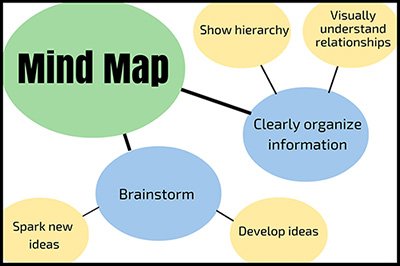
- Do not plagiarize. Cite your work and give credit where it's due. Do not take credit for others' thoughts or ideas, and make yourself aware of the basic rules for avoiding plagiarism .
- Create an outline. Make a rough outline of the sections and points of your essay. Writing your ideas down will help you organize your thoughts and see what you need to add, change, or rearrange.
- Provide evidence. Use evidence from your research to support your ideas. Each body paragraph will contain an original idea, but you will need to back it up with evidence to make it credible.
- Don't use "I" statements or make sweeping generalizations. Stay objective, and be specific.
- Grab your audience's attention. Come up with an attention-grabbing title and introduction that will make your reader want more.
- Use logic. Within each paragraph and throughout your essay, keep your ideas coherent and linear.
- Use an essay style that complements your content (and is in accordance with your professor's guidelines). There are four main types of essays:
- Expository : The writer explains an idea or issue to the reader.
- Persuasive : The writer tries to convince the reader to take his or her position on an idea, issue, or topic.
- Analytical : The writer examines and analyzes an idea, issue, or topic.
- Argumentative : The writer tries to prove that his or her position is correct.
- Answer what , why , and how . Regardless of the type of essay you write, it should answer each of these questions.
- Don't feel obliged to write your first draft in order, from introduction to bibliography. It can be difficult to write a completely linear essay when you have lots of different ideas, so start by writing whatever you're ready to write—you can put all the pieces together later. This will make the process easier and less stressful.
Introduction
The introductory paragraph broadly introduces your topic by giving your reader an overview of what your essay will be about and the points that will be discussed. It often starts with a general statement that acts as the topic sentence for the paragraph, and it provides a general discussion that leads to a specific thesis statement at the end of the paragraph.
- Do not explicitly explain your intentions. For example, do not say, "The purpose of this essay is to . . ." Instead, allow the topic sentence to help your reader identify and determine your purpose. By the time readers get to the end, they will have a comprehensive understanding of your essay and its intent.
- Choose a thesis statement that the body of your essay will be able to support. This thesis will be the "hook" of your essay, and it is often one of the last sentences in the introductory paragraph. A hook is a line that grabs the reader's attention—it "hooks" them, just like a fishing hook grabs a fish. The goal of the hook is to keep your reader interested and to clearly indicate the purpose of the essay.
The body of the essay develops the argument that was outlined in the introduction.
- Use topic sentences. The topic sentence of each paragraph provides a brief summary of what the paragraph is about.

- Set up the transition to your next point. The concluding sentence of each paragraph should function as a hook and transition into the next paragraph.
- Discuss and support a different idea in each paragraph. Limit each paragraph to one main idea. The topic sentence of each paragraph will help you organize your own thoughts and let the reader know what that paragraph is about. If you're writing a five-paragraph essay, follow this general outline:
- The first paragraph contains the strongest argument and ties into the hook at the end of the introductory paragraph. Discuss your first point, elaborate on it, and provide evidence in support of it. Close with a transitional hook.
- The second paragraph contains a more neutral argument, and it ties into the hook at the end of the first paragraph. Discuss your second point, elaborate on it, and provide evidence to support it. Close with a transitional hook.
- The third paragraph contains another strong argument and ties into the hook at the end of the second paragraph. Discuss your third point, elaborate on it, and provide evidence to support it. Close with a transitional sentence that leads smoothly into the concluding paragraph.
In contrast to the introductory paragraph, the concluding paragraph starts out specific (by reintroducing the thesis) and becomes more general. It ties your ideas together and brings your paper to a culmination.
The concluding paragraph provides a general discussion of your findings and shows the reader that you have accomplished what you intended to at the outset.
- Restate your thesis (though not necessarily using the exact same words). In contrast to the introductory paragraph, the concluding paragraph starts out specific (by reintroducing the thesis) and becomes more general. It ties your ideas together and brings your paper to a close.
- Discuss your findings based on your research and evidence. Has your thesis been proven?
- Don't introduce any new ideas. The point here is to sum up and wrap up your essay, not to confuse readers by providing new information.
- End on a high note. You can finish the essay in a variety of ways. For example, you might provide suggestions for future research, state a call to action, share a quote, or ask a question. Depending on the topic and purpose of your essay, choose a closing line that will fit well with the rest of your essay's structure and leave readers thinking " Wow! "
Bibliography/Works Cited
The Bibliography or Works Cited page is a list of all the references you used throughout the paper. It can be alphabetized or numbered depending on the style guide you are using. While a Bibliography includes every resource you consulted when preparing your essay, a Works Cited page includes only the resources cited in your essay. Find out which is required by consulting the style guide assigned by your professor.
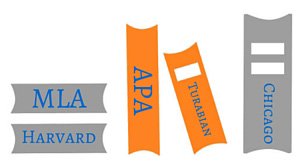
- To make creating your reference list easier, use citation software . There are many different options out there, and several of the software programs are free (especially if you're enrolled in a university that has a subscription to one of the services). These citation software programs essentially create your bibliography for you, making the process fast, easy, and accurate.
Review, Revise, Rework
- Give yourself a day or two before rereading and revising your essay. This way, you will have a fresh set of eyes, making it easier to catch any mistakes.
- Don't be afraid to rearrange paragraphs, delete sentences, or add information. Reading through your essay a few days after writing it makes it much easier to see where and how the structure needs to be changed.
- Correct any errors in spelling, grammar, and punctuation. Check the essay yourself, have a friend review it, or better yet, have your essay edited by a professional editing service .
- Avoid colloquialisms and contractions. ('Cause it just ain't professional in an academic setting. Lol.)
- Analyze the flow of your essay , and make sure that your ideas and paragraphs flow smoothly from one to the next.
- Cut out any extraneous information or fluff. We've all done it, but adding extra words to make a word count requirement doesn't fly with most professors, and it will definitely detract from the strength of your essay.
Now, it's Time to Write!
It may seem overwhelming, but writing an essay doesn't have to be stressful. After coming up with a topic, doing some research, and creating a basic outline, you're ready to start filling in the gaps. Using primary and/or secondary research, back up your ideas and support them with credible sources. Just don't forget to cite those sources! Once you've written your first draft, take a day or two away from your paper so you will have a clear head when you come back to revise it. As suggested, you may even want to have your paper edited by the professionals at Scribendi , who will not only correct any surface-level errors but will also check for consistency, clarity, and cohesiveness, providing comments and suggestions along the way.
Essay writing is so much easier if you're equipped with the right tools, and that's what we hope we've given you with this ultimate essay checklist. Now that you know how to write an essay (regardless of the style), we're confident in your ability to write an essay about any topic that your instructor might have in store for you. Happy writing!
Image sources: Foundry/Pixabay.com, succo/Pixabay.com, ClkerFreeVectorImages/Pixabay.com
Ask a Professional to Edit Your Essay
Hire one of our expert editors , or get a free sample.
Have You Read?
"The Complete Beginner's Guide to Academic Writing"
Related Posts

Escape the Five-Paragraph Essay

Essay Writing Help

How to Write a Great Thesis Statement
Upload your file(s) so we can calculate your word count, or enter your word count manually.
We will also recommend a service based on the file(s) you upload.
English is not my first language. I need English editing and proofreading so that I sound like a native speaker.
I need to have my journal article, dissertation, or term paper edited and proofread, or I need help with an admissions essay or proposal.
I have a novel, manuscript, play, or ebook. I need editing, copy editing, proofreading, a critique of my work, or a query package.
I need editing and proofreading for my white papers, reports, manuals, press releases, marketing materials, and other business documents.
I need to have my essay, project, assignment, or term paper edited and proofread.
I want to sound professional and to get hired. I have a resume, letter, email, or personal document that I need to have edited and proofread.
Prices include your personal % discount.
Prices include % sales tax ( ).


Essay Writing: A complete guide for students and teachers
P LANNING, PARAGRAPHING AND POLISHING: FINE-TUNING THE PERFECT ESSAY
Essay writing is an essential skill for every student. Whether writing a particular academic essay (such as persuasive, narrative, descriptive, or expository) or a timed exam essay, the key to getting good at writing is to write. Creating opportunities for our students to engage in extended writing activities will go a long way to helping them improve their skills as scribes.
But, putting the hours in alone will not be enough to attain the highest levels in essay writing. Practice must be meaningful. Once students have a broad overview of how to structure the various types of essays, they are ready to narrow in on the minor details that will enable them to fine-tune their work as a lean vehicle of their thoughts and ideas.

In this article, we will drill down to some aspects that will assist students in taking their essay writing skills up a notch. Many ideas and activities can be integrated into broader lesson plans based on essay writing. Often, though, they will work effectively in isolation – just as athletes isolate physical movements to drill that are relevant to their sport. When these movements become second nature, they can be repeated naturally in the context of the game or in our case, the writing of the essay.
THE ULTIMATE NONFICTION WRITING TEACHING RESOURCE

- 270 pages of the most effective teaching strategies
- 50+ digital tools ready right out of the box
- 75 editable resources for student differentiation
- Loads of tricks and tips to add to your teaching tool bag
- All explanations are reinforced with concrete examples.
- Links to high-quality video tutorials
- Clear objectives easy to match to the demands of your curriculum
Planning an essay

The Boys Scouts’ motto is famously ‘Be Prepared’. It’s a solid motto that can be applied to most aspects of life; essay writing is no different. Given the purpose of an essay is generally to present a logical and reasoned argument, investing time in organising arguments, ideas, and structure would seem to be time well spent.
Given that essays can take a wide range of forms and that we all have our own individual approaches to writing, it stands to reason that there will be no single best approach to the planning stage of essay writing. That said, there are several helpful hints and techniques we can share with our students to help them wrestle their ideas into a writable form. Let’s take a look at a few of the best of these:
BREAK THE QUESTION DOWN: UNDERSTAND YOUR ESSAY TOPIC.
Whether students are tackling an assignment that you have set for them in class or responding to an essay prompt in an exam situation, they should get into the habit of analyzing the nature of the task. To do this, they should unravel the question’s meaning or prompt. Students can practice this in class by responding to various essay titles, questions, and prompts, thereby gaining valuable experience breaking these down.
Have students work in groups to underline and dissect the keywords and phrases and discuss what exactly is being asked of them in the task. Are they being asked to discuss, describe, persuade, or explain? Understanding the exact nature of the task is crucial before going any further in the planning process, never mind the writing process .
BRAINSTORM AND MIND MAP WHAT YOU KNOW:
Once students have understood what the essay task asks them, they should consider what they know about the topic and, often, how they feel about it. When teaching essay writing, we so often emphasize that it is about expressing our opinions on things, but for our younger students what they think about something isn’t always obvious, even to themselves.
Brainstorming and mind-mapping what they know about a topic offers them an opportunity to uncover not just what they already know about a topic, but also gives them a chance to reveal to themselves what they think about the topic. This will help guide them in structuring their research and, later, the essay they will write . When writing an essay in an exam context, this may be the only ‘research’ the student can undertake before the writing, so practicing this will be even more important.
RESEARCH YOUR ESSAY
The previous step above should reveal to students the general direction their research will take. With the ubiquitousness of the internet, gone are the days of students relying on a single well-thumbed encyclopaedia from the school library as their sole authoritative source in their essay. If anything, the real problem for our students today is narrowing down their sources to a manageable number. Students should use the information from the previous step to help here. At this stage, it is important that they:
● Ensure the research material is directly relevant to the essay task
● Record in detail the sources of the information that they will use in their essay
● Engage with the material personally by asking questions and challenging their own biases
● Identify the key points that will be made in their essay
● Group ideas, counterarguments, and opinions together
● Identify the overarching argument they will make in their own essay.
Once these stages have been completed the student is ready to organise their points into a logical order.
WRITING YOUR ESSAY
There are a number of ways for students to organize their points in preparation for writing. They can use graphic organizers , post-it notes, or any number of available writing apps. The important thing for them to consider here is that their points should follow a logical progression. This progression of their argument will be expressed in the form of body paragraphs that will inform the structure of their finished essay.
The number of paragraphs contained in an essay will depend on a number of factors such as word limits, time limits, the complexity of the question etc. Regardless of the essay’s length, students should ensure their essay follows the Rule of Three in that every essay they write contains an introduction, body paragraphs, and a conclusion.
Generally speaking, essay paragraphs will focus on one main idea that is usually expressed in a topic sentence that is followed by a series of supporting sentences that bolster that main idea. The first and final sentences are of the most significance here with the first sentence of a paragraph making the point to the reader and the final sentence of the paragraph making the overall relevance to the essay’s argument crystal clear.
Though students will most likely be familiar with the broad generic structure of essays, it is worth investing time to ensure they have a clear conception of how each part of the essay works, that is, of the exact nature of the task it performs. Let’s review:
Common Essay Structure
Introduction: Provides the reader with context for the essay. It states the broad argument that the essay will make and informs the reader of the writer’s general perspective and approach to the question.
Body Paragraphs: These are the ‘meat’ of the essay and lay out the argument stated in the introduction point by point with supporting evidence.
Conclusion: Usually, the conclusion will restate the central argument while summarising the essay’s main supporting reasons before linking everything back to the original question.
ESSAY WRITING PARAGRAPH WRITING TIPS

● Each paragraph should focus on a single main idea
● Paragraphs should follow a logical sequence; students should group similar ideas together to avoid incoherence
● Paragraphs should be denoted consistently; students should choose either to indent or skip a line
● Transition words and phrases such as alternatively , consequently , in contrast should be used to give flow and provide a bridge between paragraphs.
HOW TO EDIT AN ESSAY

Students shouldn’t expect their essays to emerge from the writing process perfectly formed. Except in exam situations and the like, thorough editing is an essential aspect in the writing process.
Often, students struggle with this aspect of the process the most. After spending hours of effort on planning, research, and writing the first draft, students can be reluctant to go back over the same terrain they have so recently travelled. It is important at this point to give them some helpful guidelines to help them to know what to look out for. The following tips will provide just such help:
One Piece at a Time: There is a lot to look out for in the editing process and often students overlook aspects as they try to juggle too many balls during the process. One effective strategy to combat this is for students to perform a number of rounds of editing with each focusing on a different aspect. For example, the first round could focus on content, the second round on looking out for word repetition (use a thesaurus to help here), with the third attending to spelling and grammar.
Sum It Up: When reviewing the paragraphs they have written, a good starting point is for students to read each paragraph and attempt to sum up its main point in a single line. If this is not possible, their readers will most likely have difficulty following their train of thought too and the paragraph needs to be overhauled.
Let It Breathe: When possible, encourage students to allow some time for their essay to ‘breathe’ before returning to it for editing purposes. This may require some skilful time management on the part of the student, for example, a student rush-writing the night before the deadline does not lend itself to effective editing. Fresh eyes are one of the sharpest tools in the writer’s toolbox.
Read It Aloud: This time-tested editing method is a great way for students to identify mistakes and typos in their work. We tend to read things more slowly when reading aloud giving us the time to spot errors. Also, when we read silently our minds can often fill in the gaps or gloss over the mistakes that will become apparent when we read out loud.
Phone a Friend: Peer editing is another great way to identify errors that our brains may miss when reading our own work. Encourage students to partner up for a little ‘you scratch my back, I scratch yours’.
Use Tech Tools: We need to ensure our students have the mental tools to edit their own work and for this they will need a good grasp of English grammar and punctuation. However, there are also a wealth of tech tools such as spellcheck and grammar checks that can offer a great once-over option to catch anything students may have missed in earlier editing rounds.

Putting the Jewels on Display: While some struggle to edit, others struggle to let go. There comes a point when it is time for students to release their work to the reader. They must learn to relinquish control after the creation is complete. This will be much easier to achieve if the student feels that they have done everything in their control to ensure their essay is representative of the best of their abilities and if they have followed the advice here, they should be confident they have done so.
WRITING CHECKLISTS FOR ALL TEXT TYPES

⭐⭐⭐⭐⭐ (92 Reviews)
ESSAY WRITING video tutorials

Peer Review Checklist
Janelle schwartz, english 201.
This is to give you an idea of the type of things you should be looking for and accomplishing in both your own paper and that of your peer(s). Use what follows as a kind of checklist for determining what is working effectively in a paper and what is not.
Introduction
Has the writer (either yourself or your classmate) clearly expressed the question (major claim, thesis) that he/she has selected to analyze? What is that question?
Is there any unnecessary information included in the introduction?
Having read the entire essay, suggest an alternate way to begin the essay.
Having read the entire essay, does the introduction fit the paper?
What are the main points that are being made in each paragraph? Briefly outline the point of each paragraph and sketch the evidence given in support for each.
How is the evidence linked to the main point of the paragraph? And to the main point of the essay?
Is there any unnecessary information throughout the body of the paper, such as plot summary, excessive quotation,
or unsupported claims?
Has the writer restated (not simply repeated) the major claim of the paper in light of its discussion throughout the paper? In other words, what should the reader have learned by the end of the argument?
What is your understanding of the initial question after reading the paper? Has this understanding been adequately expressed? And does it open up the major claim to the question of its implications? (Has this major claim ultimately been placed into a broader perspective or context?)
Suggest an alternate ending to the argument. General/Misc
Suggest an alternate title. Does it express “in a nutshell” the essay’s theme? Has it followed the proper “title: subtitle” format? [Note: This assumes the paper already has a title—thus, every paper must have a title!]
What confuses you about the draft? (For example, a certain word choice, the topic and/or its presentation, the explanation of something in particular.)
Does the flow of the essay break down at any point? In other words, does the essay become hard to read or lose its coherence? Where? And how might you fix it?
Does the essay remain within the chosen text(s)? If there are any generalizations, speculations, clichés, idiomatic expressions, or colloquialisms, underline them so that you can point them out to your peer(s).
What has the writer done well in his/her essay? Provide positive comments about the strength(s) of the essay.
Revision and Editing Checklist for a Narrative Essay
Emma Kim / Getty Images
- Writing Essays
- Writing Research Papers
- English Grammar
- Ph.D., Rhetoric and English, University of Georgia
- M.A., Modern English and American Literature, University of Leicester
- B.A., English, State University of New York
After you have completed one or more drafts of your narrative essay , use the following checklist as a revision and editing guide to prepare the final version of your composition.
- In your introduction, have you clearly identified the experience you are about to relate?
- In the opening sentences of your essay, have you provided the kinds of details that will evoke your readers' interest in the topic?
- Have you clearly explained who was involved and when and where the incident occurred?
- Have you organized the sequence of events in chronological order?
- Have you focused your essay by eliminating unnecessary or repetitious information?
- Have you used precise descriptive details to make your narrative interesting and convincing?
- Have you used dialogue to report important conversations?
- Have you used clear transitions (in particular, time signals) to tie your points together and guide your readers from one point to the next?
- In your conclusion, have you clearly explained the particular significance of the experience you have related to the essay?
- Are the sentences throughout your essay clear and direct as well as varied in length and structure? Could any sentences be improved by combining or restructuring them?
- Are the words in your essay consistently clear and precise? Does the essay maintain a consistent tone ?
- Have you read the essay aloud, proofreading carefully?
- Examples of Great Introductory Paragraphs
- An Essay Revision Checklist
- 100 Persuasive Essay Topics
- Compose a Narrative Essay or Personal Statement
- How to Write a Letter of Complaint
- How to Write a Narrative Essay or Speech
- The Difference Between Revising and Editing
- How to Teach the Compare and Contrast Essay
- 6 Steps to Writing the Perfect Personal Essay
- revision (composition)
- personal statement (essay)
- A Critical Analysis of George Orwell's 'A Hanging'
- College Essay Style Tips
- Private School Application Essay Tips
- Essay Assignment: Descriptive and Informative Profile
- How to Write a Great Process Essay
Ultimate Guide to Writing Your College Essay
Tips for writing an effective college essay.
College admissions essays are an important part of your college application and gives you the chance to show colleges and universities your character and experiences. This guide will give you tips to write an effective college essay.
Want free help with your college essay?
UPchieve connects you with knowledgeable and friendly college advisors—online, 24/7, and completely free. Get 1:1 help brainstorming topics, outlining your essay, revising a draft, or editing grammar.
Writing a strong college admissions essay
Learn about the elements of a solid admissions essay.
Avoiding common admissions essay mistakes
Learn some of the most common mistakes made on college essays
Brainstorming tips for your college essay
Stuck on what to write your college essay about? Here are some exercises to help you get started.
How formal should the tone of your college essay be?
Learn how formal your college essay should be and get tips on how to bring out your natural voice.
Taking your college essay to the next level
Hear an admissions expert discuss the appropriate level of depth necessary in your college essay.
Student Stories
Student Story: Admissions essay about a formative experience
Get the perspective of a current college student on how he approached the admissions essay.
Student Story: Admissions essay about personal identity
Get the perspective of a current college student on how she approached the admissions essay.
Student Story: Admissions essay about community impact
Student story: admissions essay about a past mistake, how to write a college application essay, tips for writing an effective application essay, sample college essay 1 with feedback, sample college essay 2 with feedback.
This content is licensed by Khan Academy and is available for free at www.khanacademy.org.

- Environment
- Information Science
- Social Issues
- Argumentative
- Cause and Effect
- Classification
- Compare and Contrast
- Descriptive
- Exemplification
- Informative
- Controversial
- Exploratory
- What Is an Essay
- Length of an Essay
- Generate Ideas
- Types of Essays
- Structuring an Essay
- Outline For Essay
- Essay Introduction
- Thesis Statement
- Body of an Essay
- Writing a Conclusion
- Essay Writing Tips
- Drafting an Essay
- Revision Process
- Fix a Broken Essay
- Format of an Essay
- Essay Examples
- Essay Checklist
- Essay Writing Service
- Pay for Research Paper
- Write My Research Paper
- Write My Essay
- Custom Essay Writing Service
- Admission Essay Writing Service
- Pay for Essay
- Academic Ghostwriting
- Write My Book Report
- Case Study Writing Service
- Dissertation Writing Service
- Coursework Writing Service
- Lab Report Writing Service
- Do My Assignment
- Buy College Papers
- Capstone Project Writing Service
- Buy Research Paper
- Custom Essays for Sale
Can’t find a perfect paper?
- Essay Guide
Comprehensive Essay Checklist for Students
Table of content.
- 01. General Tips For College Essay Checklist
- 02. Structure Checklist: Three Major Elements
- 03. Points for Formatting and Works Cited List
- 04. Final Tips For Revision Checklist
- 05. Start Getting Used to Academic Success
Essay checklist is one of the best helpers students could count on in their academic pursuits. When you are writing a paper, especially with no solid experience in it, a lot of different things could confuse or perhaps intimidate you. Essay length, its formatting and content, the structure of paragraphs, research and styles of writing — everything feels foreign and complex. It is very easy to make mistakes, get a bad grade, and ruin your overall academic score. Even if one part of an essay suffers, the results will reflect it, which is something no student wants. For avoiding this unfortunate situation, having a checklist that outlines all tricky moments and general requirements is essential. You’ll be able to consult with it before, during, and after the work on an essay. This is what it’s going to include.
General Tips For College Essay Checklist
Let’s start with more general tips before narrowing the scope down and focusing on specific essay aspects. There are four major things young writers should keep in mind as they’re getting ready to start. Be sure you put a “check” across each one.
Understand what type of essay you’re writing
All papers are divided into different kinds. Some are similar while others differ from each other. From the most common types, students are usually assigned argumentative, expository, and reflective works. Find out which type of an essay has what goal. In argumentative essays, fight to prove your point of view. In expository papers, explain an issue or object by painting a clear detailed picture of it. Reflections should express an opinion on something you read or watched by presenting your reaction to it. Check the required type out— this will make an essay goal clear to you!
Choose a topic you like
Choice of essay topic idea is rarely awarded points in professors’ essay criteria, but students’ success still depends on it to a big extent. Do you like what you’ll be writing about? Try to come up with something that you find truly interesting. If it is not an option, look for an angle that you’d like to explore — even the most boring topics have one.
Maintain academic language throughout
There are several rules to follow here: don’t use first-person pronouns unless required. Never apply contractions; rely on more advanced vocabulary. High school, college, and university all have their own level of acceptable words. Seek them out online to make sure that your paper is written appropriately.
Use evidence
Every paper needs evidence, even if it has personal nature. Be sure to find credible academic sources created within the period of the last 5 or 7 years. Cite all claims that the general audience wouldn’t know — for instance, when mentioning specific numbers, years, or facts. Explain your line of thought with direct examples.

Structure Checklist: Three Major Elements
Within essay writing checklist, structure of essays plays a relevant role. There should be introduction, body, and conclusion, each of them having a specific size and vital components. This is what students should remember: intro and conclusion should take between 7-10% of the overall word count. Introduction should tease, not overwhelm readers with details. It must end with a strong thesis statement that reveals the purpose of work. Conclusion shouldn’t have new facts, so don’t present them there: simply restate information mentioned previously.
Every good paragraph checklist has special points for essay body. It has to take at least 1 paragraph, but in most cases, there will be 3 of them. College papers are a little longer while those assigned in universities could take even 10 pages, which basically makes body length unlimited. Each paragraph should have thoughtful opening and closing sentences (no direct quotes can be present), and you shouldn’t regard more than one content point in it.
Points for Formatting and Works Cited List
Formatting is an often unpleasant but vital part of assignments. In this checklist for writing, we’ll settle on the key aspects that deserve your attention.
- Ask for formatting template. Students could write papers in MLA, APA, Chicago, Harvard formats, etc. Ask for templates if they weren’t given and follow them closely.
- Check useful citing sites. Before citing a source, check how reliable sites suggest doing it. For example, when adding citation for a book in MLA format, look how it should be done for in-text as well as bibliography instances.
- Mention all details. In most formats, you’ll have to mention authors’ names, date of publication, title, journal along with volume if available, DOI or link, publishing agency, etc. For more specific info, check out templates we discussed above.
Remember! You may always use the conclusion generator free .
Final Tips For Revision Checklist
The time for final essay checking and re-checking has come. The more attentive you are here, the more chances of succeeding you’ll stand. Take note of the following steps:
Take a break and re-read what you wrote
If you read essay again immediately, you risk losing objectivity. At this point, it is difficult to detach yourself from your own writing. So, wait for a few hours or even days and look at this work with a new pair of eyes.
Watch out for grammar
Start editing and correcting your essay . Watch every sentence attentively, preferably reading it out loud. Look at punctuation, tenses, missing words, and so on.
Evaluate the flow
Content should be subject to scrutiny as well. Do all your ideas sound strong? Is there enough evidence presented to support them? Have all claims been cited? Paragraph flow is equally important. Pay attention to transitions between them: you cannot end a paragraph with one idea and jump toward another with no warning or hint. Everything should flow smoothly.
Start Getting Used to Academic Success
As you can see from our essay checklist, there is a huge number of points that require writers’ close attention. But don’t let it scare you: with practice, you will learn to do everything automatically. Consider your time carefully. It is always better to start working early than let the deadline approach and plunge into panic. Conduct detailed research, consult with professors or other students, and seek writing help online if you need it. During the first times you’re working on a paper, keep essay writing checklist close. Look at it from point to point, making sure you cover everything. Editing is always needed: never think that you’re done when you finish writing. As long as you remain attentive and thorough, you won’t face any serious issues.
A few hours till deadline?
Let experts write a unique essay and save your time
Blog Navigation
- Comparison and Contrast
Can’t come up with a topic for you paper? We’ve prepared a collection of essay topics for you
Want to write a winning essay but lack experience? Browse our free essay samples

Elizabeth provides educational materials, conducts research, explores and solves student challenges. Her posts are always helpful, innovative, and contain interesting insights.
Related Articles
These days, it s impossible to find a student who wouldn t have heard about a Chat GPT essay writer. AI keeps transforming the academic sphere: it consistently simplifies research, helps generate ideas, and now it also takes care of the entire writing process. But is it truly that efficient?...
Not all students know how to write a definition essay. This type of task is pretty rare as for the most part, professors prefer more complex papers, like argumentative or descriptive ones. But when they finally assign it, students start panicking because they don t understand what it means and...
A request for learning how to write a comparison and contrast essay is extremely popular in online spaces. Students from countries all over the world type it when they receive this kind of college assignment, hoping to find clear answers and instructions. If you re here, then you ve come...
A surprising number of students feel unsure about how to write an informative essay. On the one hand, everything seems pretty easy: the name of this college task speaks for itself. An informative paper is a piece of writing where you present objective facts about a specific topic, expanding your...
At some point, every college student wonders, how to write an argumentative essay? It s a common task in all educational establishments, regardless of what country you re from or what major you re specializing in. An argumentative essay is a piece of academic writing where you provide your view...
If you re wondering how to write an expository essay, you ve come to the right place. This common college task always wreaks chaos among the students, making them panic in their attempts to understand what they should be doing now. The first thing students need lies in understanding what...
What are your chances of acceptance?
Calculate for all schools, your chance of acceptance.
Your chancing factors
Extracurriculars.
College Essay Checklist: Are You Ready to Submit?
←Whom Should I Ask for Help with My College Essay?
How Long Should Your College Essay Be?→
The college admissions process is a human process. An admissions committee filled with real people will evaluate your application, and these people will choose whether to advocate for you to gain admission to the university. So in order to be accepted, you need to stand out from the other applicants and persuade the admissions committee to choose you over students with a similar academic profile. Luckily, college essays are specifically designed to be your tool to stand out in the admissions process.
Given that college essays are so important, it’s important to make sure that they are absolutely perfect before you submit them. How do you make sure your college essays are ready to send to colleges? Make sure you’ve gone through this checklist before you hit that “submit” button!
Why Are College Essays So Important?
A college application has many components – test scores, grades and coursework, your extracurricular profile, recommendation letters, interviews, and, of course, your essays. So why are the essays such an important part if there are so many other components of your application to consider?
Well, most colleges receive thousands of applicants, many of whom have similar academic and extracurricular profiles. In fact, for every spot in a selective university’s admitted class, there are at least four outstanding applicants with similar grades and test scores. So how do admissions committees choose among so many students who have such strong potential? They use their essays to decide who would best fit in with the campus community.
For this reason, your college essays aren’t just about showing off your abilities and accomplishments. It’s about showing who you are as a person, what your values are, and what you’re passionate about. That’s no small task for a short essay. Every word is going to count, so follow the checklist below to make sure that your essay is as strong as it can be.
College Essay Checklist: Before You Submit
1. does your essay share who you are and what you care about.
Your essay needs to be personal. It should share your personality, goals, and voice. Even if a prompt doesn’t explicitly ask you who you are and what you care about, you should use it as an opportunity to showcase your personal qualities. For example, take the following supplemental essay prompt from the University of Chicago’s 2020 Application:
What can actually be divided by zero?
At first glance, this prompt may seem confusing. After all, didn’t we all learn in elementary school math classes that nothing can be divided by zero? More abstract, philosophical prompts like this one are actually ripe opportunities for students to showcase who they are and how they think.
So if you answered a prompt like this very practically, e.g. explaining that the laws of mathematics prove that no real number can be divided by zero, you’re missing out on a key opportunity to show the admissions committee your capability for creativity and abstract thought. Instead of answering a prompt like this literally, you ought to think critically about your own life and see if you can metaphorically or rhetorically link the question to something you have gone through or accomplished.
Alternatively, if you’re more of a logical person and want to answer the question analytically, make sure that you are showcasing your knowledge of various theorems and strategies, and be sure to cite where you learned them. Either way, you are showing the admissions committee how your brain works and how you go about solving problems.
Remember: the goal of an essay is, first and foremost, to showcase yourself. There are no right or wrong answers in college essays, so as long your essay tells the committee something important about you.
2. Do your essays form a portfolio that accurately represents you?
While having to write so many essays is a lot of work, there is an upside. Having multiple essays means you can use each essay to display a different aspect of yourself and your accomplishments. That way, holistically, your application will give a very representative picture of who you are, and you won’t have to leave anything out.
So when you’re evaluating your essays, ask yourself: do your essays depict as many facets of yourself as possible? Specifically, have you repeated a story, experience or quality about yourself in any of the essays you’re going to send to the same college? If you have, then consider editing one of the essays to highlight something that you haven’t yet shared with the admissions committee. The more you can share with them in a limited amount of space, the easier it will be for the admissions committee to imagine how you would fit in at their university.

3. Did you answer the prompt?
Okay, so we’ve talked a lot about making sure that your values, passions, and accomplishments are showcased in your essays, even if the prompt is more abstract. This is certainly important, but it’s also important to make sure you’re showcasing yourself in the context of the essay prompt that was given to you. In other words, you should be sure that at some point in your essay, you answer the essay prompt clearly. If you don’t, you risk coming across as a student who doesn’t know how to follow basic directions.
Moreover, you need to make sure that you answer every part of the essay prompt given. Some essay prompts will just have one part. Some will have many. If you have to answer an essay prompt with multiple parts, be sure you address all of them. Take the following essay prompts from the 2019-2020 College Application Cycle:
Massachusetts Institute of Technology , 2019-2020:
Tell us about the most significant challenge you’ve faced or something important that didn’t go according to plan. How did you manage the situation? (200-250 words)
University of California :
What would you say is your greatest talent or skill? How have you developed and demonstrated that talent over time? (350 words)
In both of these prompts, you are asked to respond to two related questions. If you were to answer the MIT prompt, you would need to not only describe a significant challenge but explain how you overcame it. For the University of California prompt, you’d not only need to explain your greatest skill but outline how you’ve cultivated it over time. If you miss any of those parts in your response, you will not have fully answered the prompt.
4. Did You Stay Within the Word Count?
Most main college essays (like the Common App essays) have a word limit of anywhere from 250-650 words. Supplemental essay prompts generally have word limit of 100-400 words. Either way, you need to make sure that you stay very close to the upper word limit in your response.
As a general rule, you should try to stay within 10% of the upper word limit. So if the word limit for one of your essays is 650 words, your essay shouldn’t be fewer than 585 words. Keep in mind that most online applications will cut off your essay at the word limit, so try not to go over the word count. However, on the other extreme, you don’t want to make your essay too short, as it may make it seem like you don’t care about the application. After all, every extra bit of space in your essays is an opportunity to further impress the admissions committee, so you should take advantage of it.
For some more details on how long your college essays should be, check out our previous post entitled How Long Should Your College Essay Be? What is the Ideal Length?
5. Did You Proofread?
Here are some things to look out for as you look over your essay:
Incorrect grammar and spelling mistakes. These can make a well-thought-out essay seem subpar in the eyes of an admissions committee.
Awkward or formal wording. Read your essay aloud and listen to how it sounds. If it doesn’t sound natural, then you’re likely not displaying your authentic self to the admissions committee. Consider shifting some of the wording to sound more like something you would actually say, even if it means you have to take out a bit of the advanced vocabulary and complex sentence structure.
Instances of telling, instead of showing. One of the biggest mistakes students make is to tell, instead of show. Here’s an example of telling: “It was a rainy and gloomy day.” Here’s an example of showing: “The gray clouds hovered ominously above the lake. I felt a drop. Then another. And another. It began pouring, and I frantically tried to row the canoe back to shore.” It’s much more engaging to read the second example, as you feel as if you’re there with the writer.
Repeated sentence structure and vocab. Do you use the same word over and over again? Do you begin lots of sentences in a row with “I”? As you’re reading your essay, make sure that you’re using varied language to keep things interesting.
Inconsistent style. While your language should be varied, your style shouldn’t. If you use contractions or acronyms, use them throughout the essay. If you begin the essay in past tense, keep it that way, or make sure there’s clear demarcation when you shift tenses.
Also, if you’re reused an essay from another school’s application, give it an extra read-through to make sure that you’ve replaced all of the mentions of and references to the other college. You don’t want the admissions committee from UC Berkeley reading about how thrilled you are to take advantage of the opportunities that Tufts has to offer. It would not bode well for your likelihood of acceptance to Berkeley.
Of course, it is okay to reuse essays if the prompts are similar, but just be sure to double and triple-check that it doesn’t seem like you’re reusing an essay meant for another college. Also, if you’re answering the famous “ Why This College ” essay, we at CollegeVine recommend that you not reuse another essay. This essay should include specific resources and opportunities that you plan to take advantage of at each university, so you shouldn’t be able to use the same essay for two different schools. In fact, if you’re able to reuse a “Why This College” essay, that’s a sign that you need to rework the essay and make it more specific to the college.
6. Did You Get a Second and Third Set of Eyes on Your Essay?
It’s important to get another person or two to read your essay before you submit. The best people to look at your essays are those who are well-versed in creative essay writing, but also people who know you well. Older peers who have gone through the admissions process successfully can offer some of the best advice. English or Communications teachers who know you well also make great proofreaders, as do writing-proficient friends and family.
If you’re not sure who to ask, you can also use our free peer essay review tool . You can get feedback on your essays, and improve your own writing skills by reviewing others’ essays.
7. Did You Revise and Proofread Again?
Once you’ve read through your essays and had others give suggestions, make the necessary edits and corrections. Then, be sure you proofread your essays one more time before you hit submit. You should try not to submit an essay that hasn’t been read at least a few times all the way through, without any changes. Consider even reading your essay out loud and printed out (have a pen at the ready!), as you may catch things you missed when reading silently.
Want help with your college essays to improve your admissions chances? Sign up for your free CollegeVine account and get access to our essay guides and courses. You can also get your essay peer-reviewed and improve your own writing skills by reviewing other students’ essays.
Related CollegeVine Blog Posts


IEW® in High School
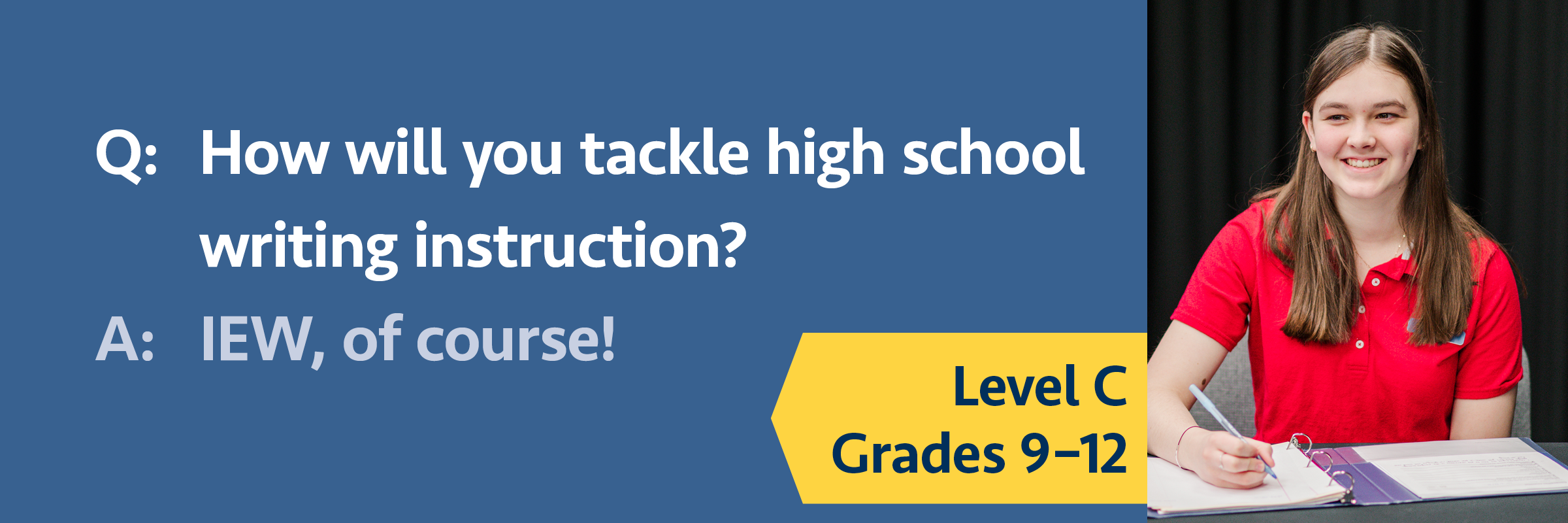
The high school years can be daunting, but writing does not have to be. IEW teaches students how to navigate the essays, research papers, and literary analysis that they will need to succeed in high school and beyond. IEW’s pathway for high school is designed to help beginning students gain confidence while continuing to bring new insights and challenges to those who have many years of IEW experience.
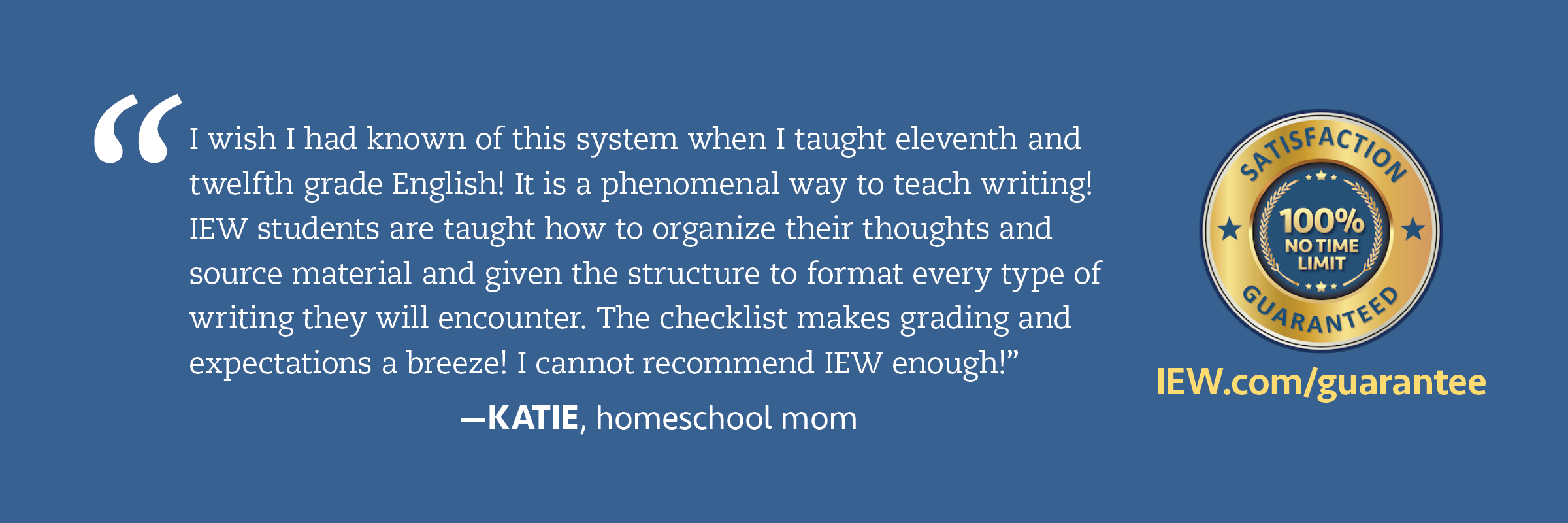
Structure and Style ® for Students: Year 1 Level C
In this course, join Andrew Pudewa as he leads students on a 24-week writing journey using IEW’s Structure and Style approach. Students reading at a 9th grade level or higher will take delight in Mr. Pudewa’s humorous, incremental, and effective writing lessons. The curriculum provides clear daily assignments and includes vocabulary words, literature suggestions, and lesson plans for teachers. Easy to use and affordable, Structure and Style for Students brings a successful solution to your writing lessons—guaranteed! Try three weeks free !
Structure and Style ® for Students: Year 2 Level C
Take students to the next level in their Structure and Style writing journey! Twenty-four more weeks of incredible writing instruction await with the humorous and engaging Andrew Pudewa. Students who have completed Year 1 Level C and are ready for their second year of the Structure and Style for Students video course will enjoy reviewing and refining the nine previously learned IEW units and response to literature, then pressing on into full literary analysis. The curriculum provides clear daily assignments and includes vocabulary words, literature suggestions, and lesson plans for teachers. Easy to use and affordable, the second year of Structure and Style for Students builds on the skills learned in the previous video course and brings a successful solution to your writing lessons—guaranteed!
University-Ready Writing
In this twelve-week video course, high school and college students learn effective note-taking strategies as they write précis (summaries) and essays, tackling assignments of varying lengths from one paragraph to several pages. With tips and tools for writing an abstract, creating and arranging content, citing sources, applying various style guides, using literary devices, and writing on-demand essays, this curriculum will prepare your students for university writing assignments. Try two weeks free !
Introduction to Public Speaking
In this twelve-week course, middle- and high-school students learn memory and delivery techniques as they write and present five speeches: self-introductory, narrative, expository, persuasive, and impromptu. Students evaluate recorded speeches in preparation for self-evaluation. This self-explanatory program empowers teachers to help students become competent and confident public speakers. Try two weeks free !
Advanced U.S. History-Based Writing Lessons†
Follow the course of U.S. history from Explorers to Modern Times while learning to write with structure and style.
Bible-Based Writing Lessons†
Delve into Bible stories and themes while learning to write with structure and style.
Phonetic Zoo Spelling Level C
Looking for a new approach to spelling? This phonics-based program uses auditory input to ensure that the correct spelling of each word is absorbed by the brain. The audio allows students to work independently much of the time while allowing for the repetition needed for mastery.
† Contains distinctly Christian content
What might a pathway look like for a student starting out with IEW in ninth grade?
If your student is reading at grade level, we recommend starting with the Structure and Style for Students: Year 1 Level C Premier package for you and your student in ninth grade. Tenth grade would be a good time to use Windows to the World taught in conjunction with Teaching the Classics or taught as a one-semester class paired with Introduction to Public Speaking. For eleventh grade, use Structure and Style for Students: Year 2 Level C. Andrew Pudewa discusses additional options for your high school student in his conference talk Hacking High School: Rethinking the Teen Years . Grammar, spelling, public speaking, and entrepreneurship can be added as well. Call, chat, or email us for additional support with making decisions!
I have a high school senior. Where should I start with IEW to make sure he gets as much writing instruction as possible before graduation?
Structure and Style for Students: Year 1 Level C provides a solid foundation in writing while also expanding into more advanced essay models such as research papers and persuasive essays. Take it one step further and hone your student’s grammar expertise before he enters college or the workforce. Fix It!™ Grammar will provide you with a full-year grammar course. In the Fix It! Grammar language arts and grammar curriculum, students internalize the rules instead of just memorizing them. That’s because Fix It! Grammar encourages students to critically analyze an ongoing story by searching for and fixing embedded errors, and in the process, students incorporate accurate punctuation and correct grammar more easily into their own compositions. To ensure you start the program at your student’s level of ability, we recommend reviewing the skills listed for each level on the Fix It! Grammar landing page.
Does IEW count as a full high school English credit?
High school credits vary depending on where you live. Please check with your state homeschool organization for the best way to calculate credits for your particular student. English encompasses communication skills: composition (writing), literature, public speaking, grammar, and may also include vocabulary and spelling. You will need to make sure you are covering all of the requirements for your state . Lee Binz with www.homehighschoolhelp.com understands the difficulty in creating high school transcripts and is dedicated to providing parents with specific beneficial answers to transcript questions. If you have questions about high school credits and transcripts, we encourage you to contact her . She will be happy to help.
Is IEW for High School? webinar
De-Confusing Essays article
Six Calming Answers to Six Panicky Questions about High School English for Homeschoolers article
Hacking High School: Rethinking the Teen Years – presentation by Andrew Pudewa
Most of us have presuppositions about what high school is based on our own experience. Times are changing, and the opportunities for home educating high schoolers have grown rapidly. Many of these opportunities will save time, help your family avoid higher education debt, and give your teens a head start on their next decade of life. Watch or listen at IEW.com/HHS

Dual Enrollment through CHI – College Credit Using IEW Materials
IEW high school students can receive college credit for English Composition I and II from a fully accredited university through Christian Halls International. Learn more at IEW.com/CHI
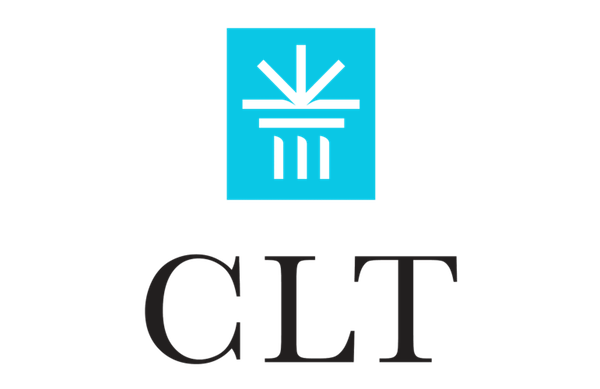
Classic Learning Test – Standardized Test
Classic Learning Test (CLT) exams serve as an alternative to Common Core-based assessments and help to highlight the unique strengths of homeschool, private school, or charter school students. CLT exams are accepted at over two hundred colleges! Find out more by visiting IEW.com/CLT and get a CLT discount code!
Editing Checklist for Self- and Peer Editing

About this printout
This helpful tool will give your students the opportunity to edit their own writing and then observe as their peers edit the same work.
Teaching with this printout
More ideas to try, related resources.
Before you begin, be sure to model and discuss each step of the writing process (prewriting, drafting, revising, editing, and publishing), preferably using a whole-class story or class newsletter article. Please note that the revising stage precedes editing. Student should have already worked through content revisions before reaching the editing step. When they are ready for the editing stage of the writing process, students should edit their writing and then meet with a partner to engage in peer editing. Prior to having students use this tool independently, it is important to model its use. To do this, display sample text on an overhead projector, document camera, or SMART Board so that all students can view it. Model the use of the self-edit column with the displayed text, with you assuming the role of author. Then have a volunteer fill out the peer-edit column so that all students can hear and view the process. Finally, discuss what went well and what could be improved in the editing steps that were modeled. This tool serves multiple purposes, including:
- The self-edit step
encourages students to evaluate specific features of their writing, increasing self-awareness of writing conventions keeps the pen in the writer’s hand for the initial editing phase
- The peer-edit step
helps build a learning community in which peers work collaboratively heightens the awareness of various print and grammatical conventions for the peer editor and the author
- Use a fish-bowl technique to allow the class to view a self- and peer-edit session of two of their classmates. To do this, first choose one student to model the self-editing phase. It is helpful to select a student who has a good understanding of the criteria on the rubric, such as proper grammar and punctuation. That student works through the items in the self-edit column as the other students observe. It is helpful to put the editing checklist on an overhead projector or document camera so all students can see the process. After the self-edit is complete, discuss the process with the students. Next, choose another student to serve as the peer editor for the piece that was just self-edited. Have the two students sit in the middle of the class so that all students can see and hear them as they work through the peer-editing phase. Afterward, include the entire class in a discussion about the process itself and ways in which the editing session will help the author and peer editor improve on their writing.
- Have students work in groups of two or three to edit one piece of writing. The interaction between peers will help make the editing process more explicit. While the students are working in groups, move from group to group to check their understanding of the editing process and use of the checklist. Try to notice groups that lack comments in the “Comments and Suggestions” columns and encourage them to use this section to provide feedback to the writer, particularly for criteria that lack a check mark. To guide them, you could ask, “What do you think you could write in the ‘Comments’ section to help the writer fix this error?” Be sure to tell students that if they are unable to mark a check in the “After completing each step, place a check here” column, they must indicate the reason why they cannot check it in the “Comments and Suggestions” column.
- If your school uses a team approach for grouping students (a group of students who all share the same content area teachers), consider encouraging other team teachers to use this checklist in their respective content areas. Consistency in the editing process will help students understand that the editing process can apply to all written pieces, regardless of the content area.
- Strategy Guides
- Lesson Plans
This strategy guide explains the writing process and offers practical methods for applying it in your classroom to help students become proficient writers.
- Print this resource
Explore Resources by Grade
- Kindergarten K
- Grades 6-12
- School Leaders
Enter Today's Teacher Appreciation Giveaway!
The Big List of Essay Topics for High School (120+ Ideas!)
Ideas to inspire every young writer!
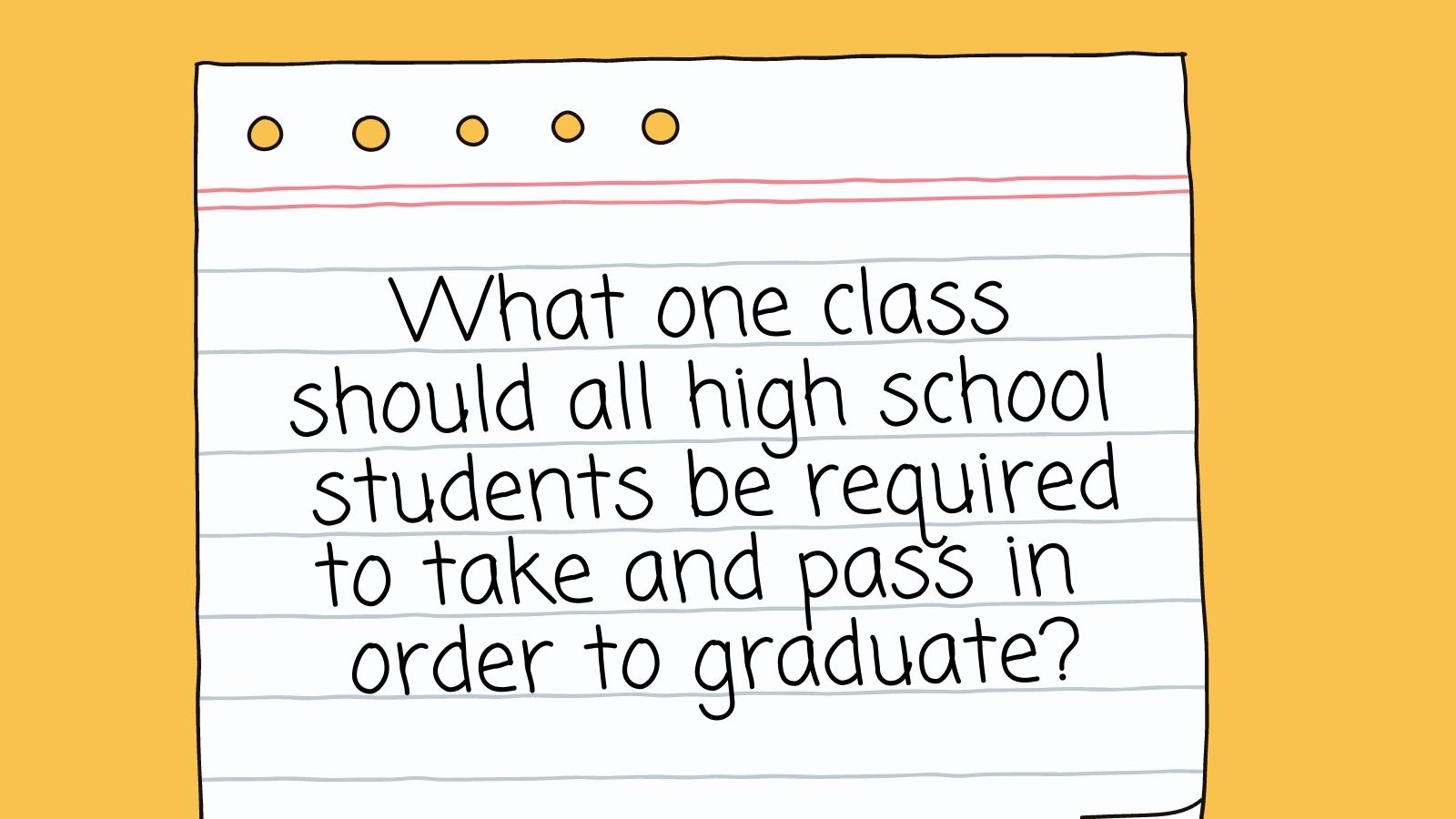
High school students generally do a lot of writing, learning to use language clearly, concisely, and persuasively. When it’s time to choose an essay topic, though, it’s easy to come up blank. If that’s the case, check out this huge round-up of essay topics for high school. You’ll find choices for every subject and writing style.
- Argumentative Essay Topics
- Cause-and-Effect Essay Topics
- Compare-Contrast Essay Topics
- Descriptive Essay Topics
- Expository and Informative Essay Topics
- Humorous Essay Topics
Literary Essay Topics
- Narrative and Personal Essay Topics
- Personal Essay Topics
- Persuasive Essay Topics
Research Essay Topics
Argumentative essay topics for high school.
When writing an argumentative essay, remember to do the research and lay out the facts clearly. Your goal is not necessarily to persuade someone to agree with you, but to encourage your reader to accept your point of view as valid. Here are some possible argumentative topics to try. ( Here are 100 more compelling argumentative essay topics. )
- The most important challenge our country is currently facing is … (e.g., immigration, gun control, economy)
- The government should provide free internet access for every citizen.
- All drugs should be legalized, regulated, and taxed.
- Vaping is less harmful than smoking tobacco.
- The best country in the world is …
- Parents should be punished for their minor children’s crimes.
- Should all students have the ability to attend college for free?
- Should physical education be part of the standard high school curriculum?
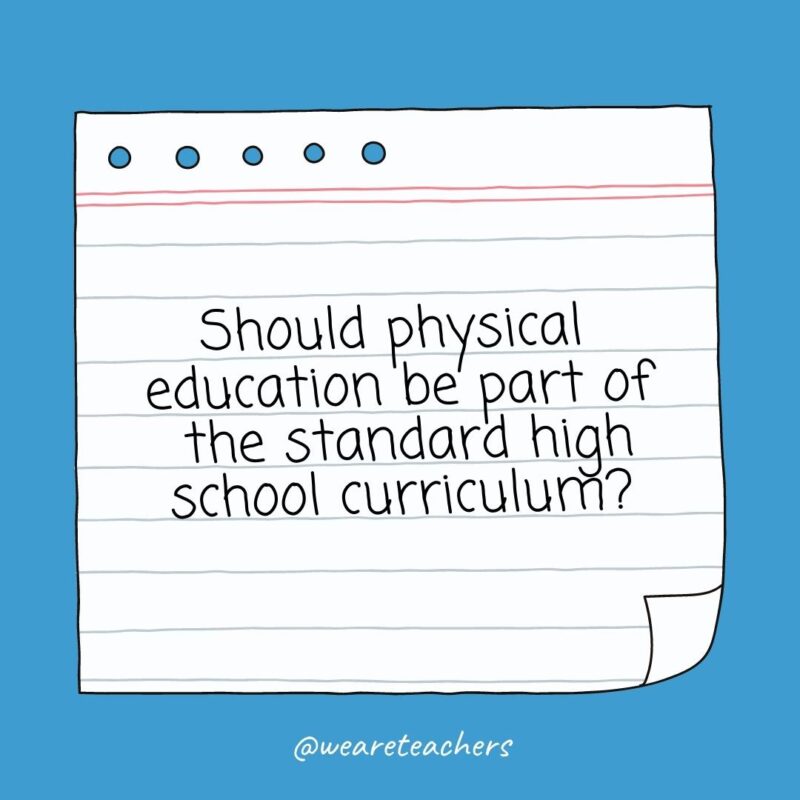
WeAreTeachers
- Schools should require recommended vaccines for all students, with very limited exceptions.
- Is it acceptable to use animals for experiments and research?
- Does social media do more harm than good?
- Capital punishment does/does not deter crime.
- What one class should all high schools students be required to take and pass in order to graduate?
- Do we really learn anything from history, or does it just repeat itself over and over?
- Are men and women treated equally?
Cause-and-Effect Essay Topics for High School
A cause-and-effect essay is a type of argumentative essay. Your goal is to show how one specific thing directly influences another specific thing. You’ll likely need to do some research to make your point. Here are some ideas for cause-and-effect essays. ( Get a big list of 100 cause-and-effect essay topics here. )
- Humans are causing accelerated climate change.
- Fast-food restaurants have made human health worse over the decades.
- What caused World War II? (Choose any conflict for this one.)
- Describe the effects social media has on young adults.
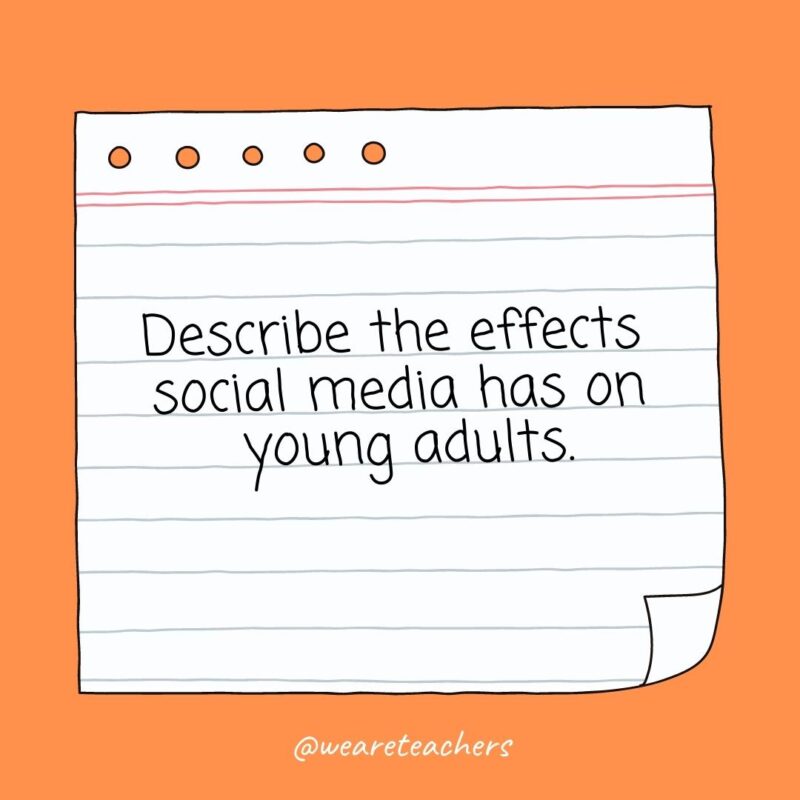
- How does playing sports affect people?
- What are the effects of loving to read?
- Being an only/oldest/youngest/middle child makes you …
- What effect does violence in movies or video games have on kids?
- Traveling to new places opens people’s minds to new ideas.
- Racism is caused by …
Compare-Contrast Essay Topics for High School
As the name indicates, in compare-and-contrast essays, writers show the similarities and differences between two things. They combine descriptive writing with analysis, making connections and showing dissimilarities. The following ideas work well for compare-contrast essays. ( Find 80+ compare-contrast essay topics for all ages here. )
- Public and private schools
- Capitalism vs. communism
- Monarchy or democracy
- Dogs vs. cats as pets
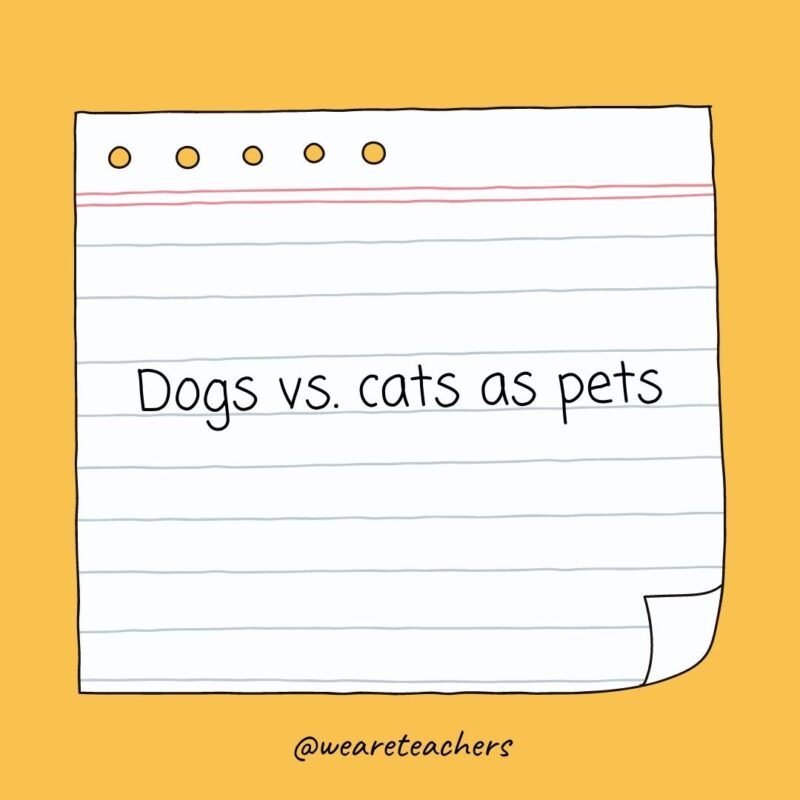
- Paper books or e-books
- Two political candidates in a current race
- Going to college vs. starting work full-time
- Working your way through college as you go or taking out student loans
- iPhone or Android
- Instagram vs. Twitter (or choose any other two social media platforms)
Descriptive Essay Topics for High School
Bring on the adjectives! Descriptive writing is all about creating a rich picture for the reader. Take readers on a journey to far-off places, help them understand an experience, or introduce them to a new person. Remember: Show, don’t tell. These topics make excellent descriptive essays.
- Who is the funniest person you know?
- What is your happiest memory?
- Tell about the most inspirational person in your life.
- Write about your favorite place.
- When you were little, what was your favorite thing to do?
- Choose a piece of art or music and explain how it makes you feel.
- What is your earliest memory?
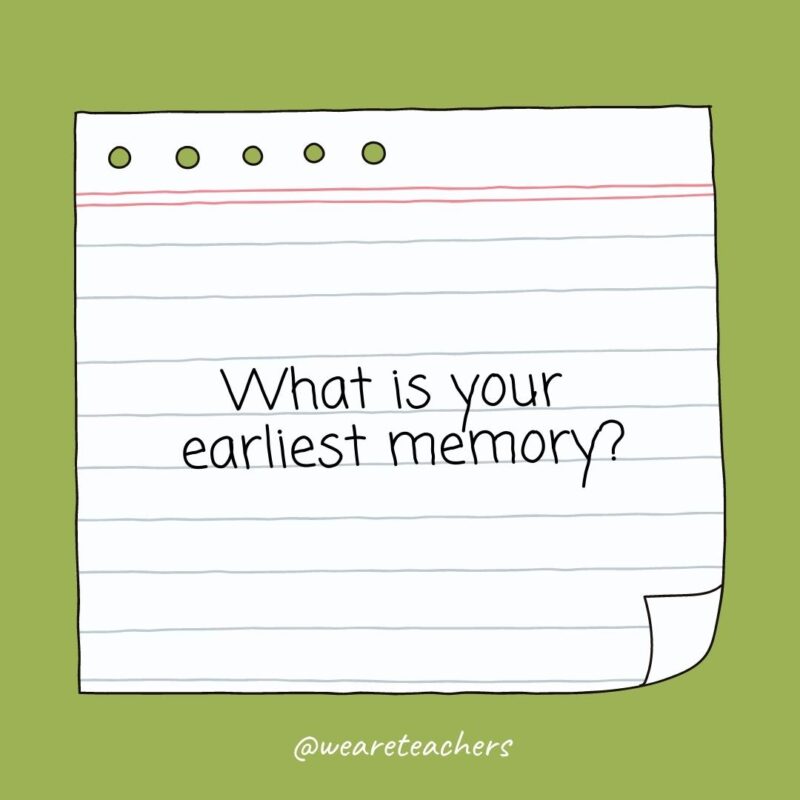
- What’s the best/worst vacation you’ve ever taken?
- Describe your favorite pet.
- What is the most important item in the world to you?
- Give a tour of your bedroom (or another favorite room in your home).
- Describe yourself to someone who has never met you.
- Lay out your perfect day from start to finish.
- Explain what it’s like to move to a new town or start a new school.
- Tell what it would be like to live on the moon.
Expository and Informative Essay Topics for High School
Expository essays set out clear explanations of a particular topic. You might be defining a word or phrase or explaining how something works. Expository or informative essays are based on facts, and while you might explore different points of view, you won’t necessarily say which one is “better” or “right.” Remember: Expository essays educate the reader. Here are some expository and informative essay topics to explore. ( See 70+ expository and informative essay topics here. )
- What makes a good leader?
- Explain why a given school subject (math, history, science, etc.) is important for students to learn.
- What is the “glass ceiling” and how does it affect society?
- Describe how the internet changed the world.
- What does it mean to be a good teacher?
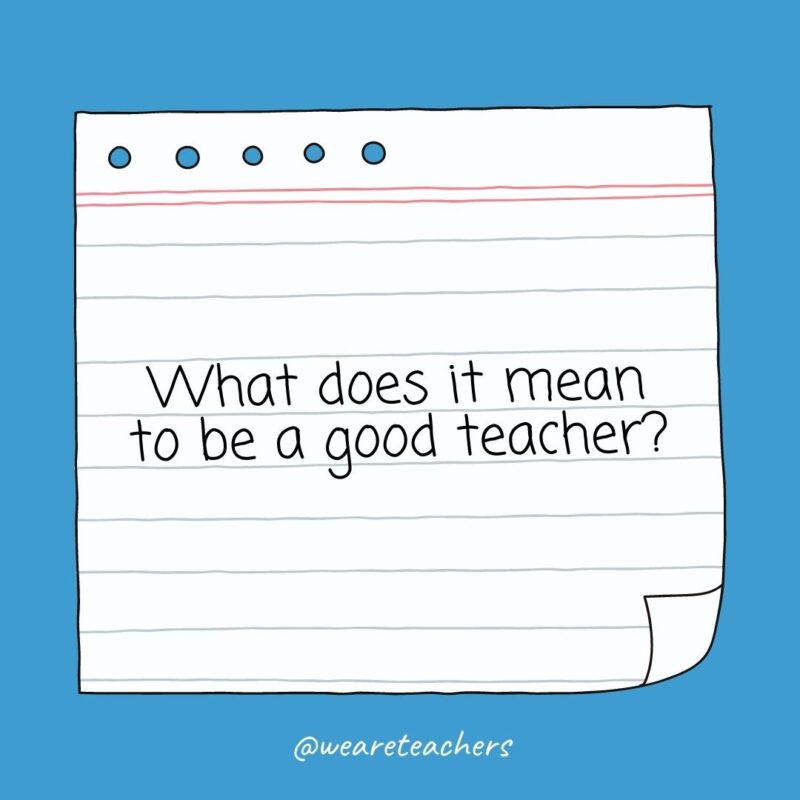
- Explain how we could colonize the moon or another planet.
- Discuss why mental health is just as important as physical health.
- Describe a healthy lifestyle for a teenager.
- Choose an American president and explain how their time in office affected the country.
- What does “financial responsibility” mean?
Humorous Essay Topics for High School
Humorous essays can take on any form, like narrative, persuasive, or expository. You might employ sarcasm or satire, or simply tell a story about a funny person or event. Even though these essay topics are lighthearted, they still take some skill to tackle well. Give these ideas a try.
- What would happen if cats (or any other animal) ruled the world?
- What do newborn babies wish their parents knew?
- Explain the best ways to be annoying on social media.
- Invent a wacky new sport, explain the rules, and describe a game or match.
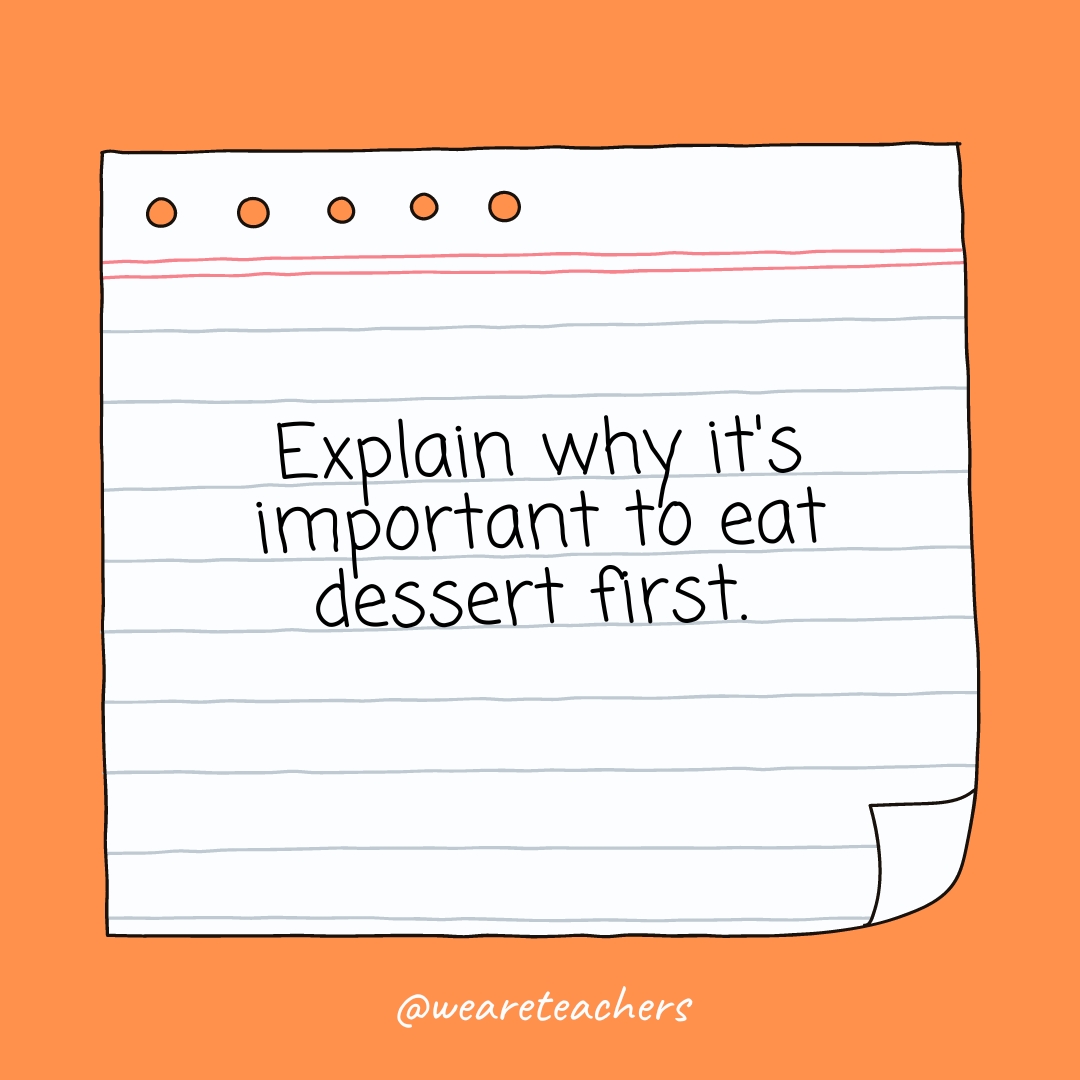
- Imagine a discussion between two historic figures from very different times, like Cleopatra and Queen Elizabeth I.
- Retell a familiar story in tweets or other social media posts.
- Describe present-day Earth from an alien’s point of view.
- Choose a fictional character and explain why they should be the next president.
- Describe a day when kids are in charge of everything, at school and at home.
Literary essays analyze a piece of writing, like a book or a play. In high school, students usually write literary essays about the works they study in class. These literary essay topic ideas focus on books students often read in high school, but many of them can be tweaked to fit other works as well.
- Discuss the portrayal of women in Shakespeare’s Othello .
- Explore the symbolism used in The Scarlet Letter .
- Explain the importance of dreams in Of Mice and Men .
- Compare and contrast the romantic relationships in Pride and Prejudice .
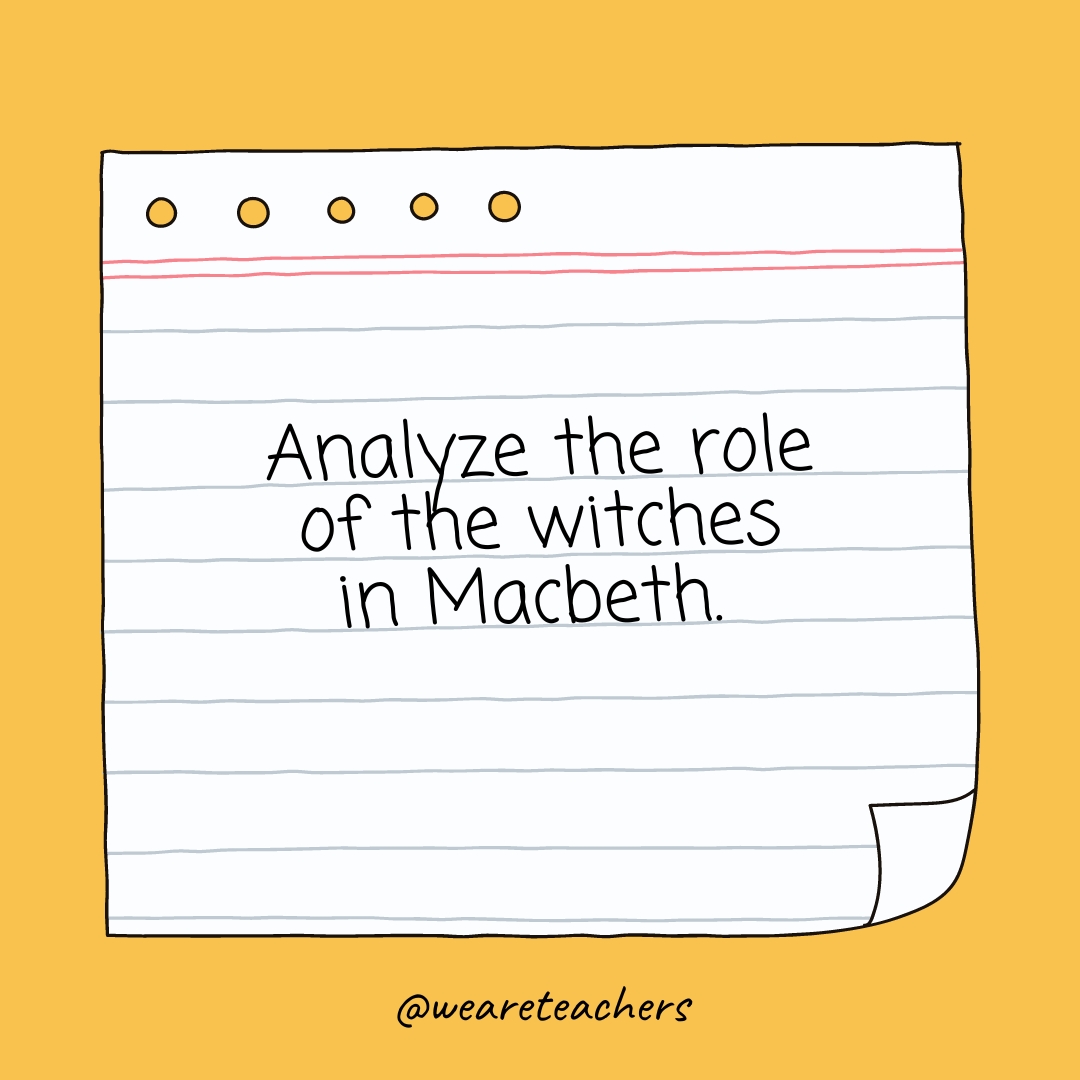
- Dissect the allegory of Animal Farm and its relation to contemporary events.
- Interpret the author’s take on society and class structure in The Great Gatsby .
- Explore the relationship between Hamlet and Ophelia.
- Discuss whether Shakespeare’s portrayal of young love in Romeo and Juliet is accurate.
- Explain the imagery used in Beowulf .
Narrative and Personal Essay Topics for High School
Think of a narrative essay like telling a story. Use some of the same techniques that you would for a descriptive essay, but be sure you have a beginning, middle, and end. A narrative essay doesn’t necessarily need to be personal, but they often are. Take inspiration from these narrative and personal essay topics.
- Describe a performance or sporting event you took part in.
- Explain the process of cooking and eating your favorite meal.
- Write about meeting your best friend for the first time and how your relationship developed.
- Tell about learning to ride a bike or drive a car.
- Describe a time in your life when you’ve been scared.
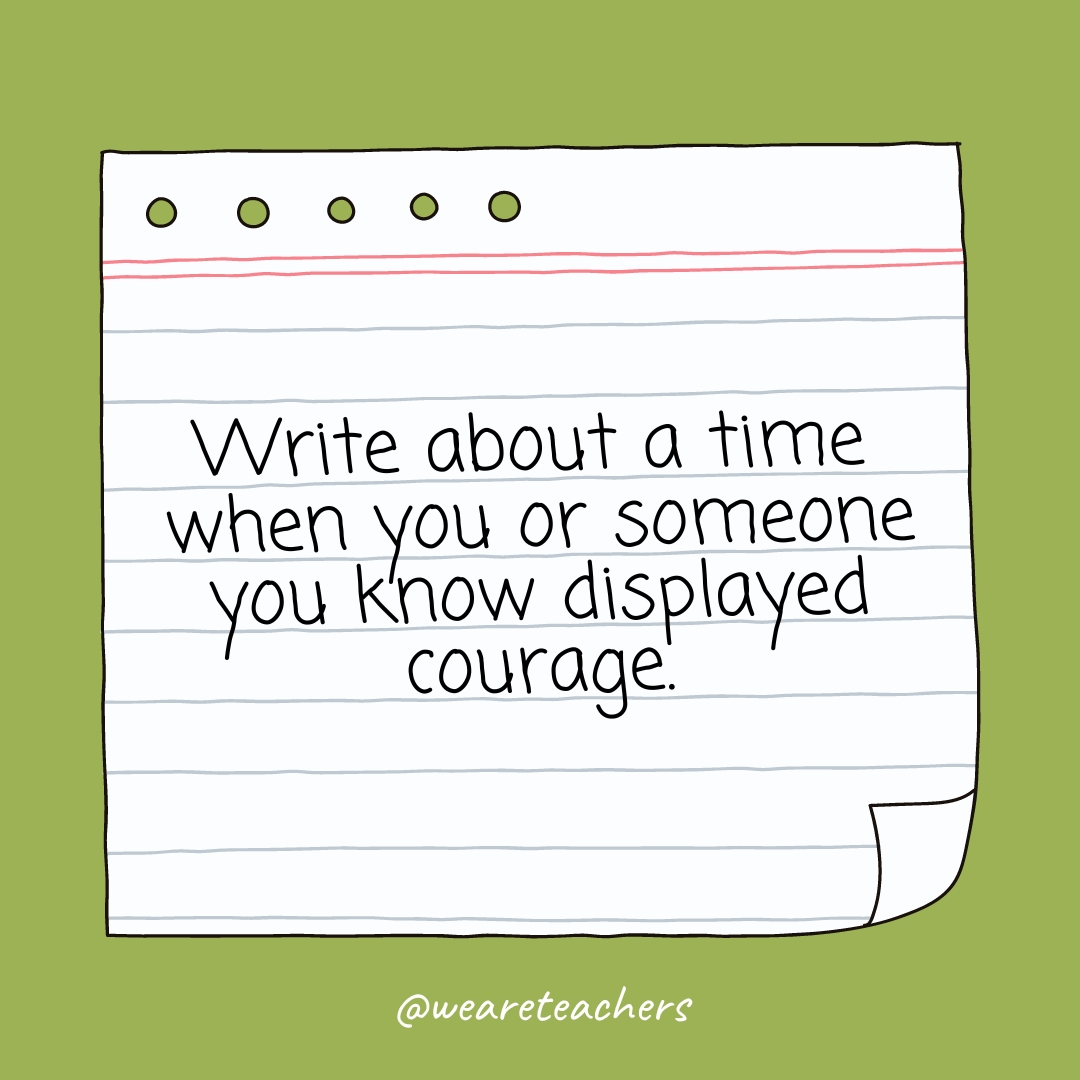
- Share the most embarrassing thing that ever happened to you.
- Tell about a time when you overcame a big challenge.
- Tell the story of how you learned an important life lesson.
- Describe a time when you or someone you know experienced prejudice or oppression.
- Explain a family tradition, how it developed, and its importance today.
- What is your favorite holiday? How does your family celebrate it?
- Retell a familiar story from the point of view of a different character.
- Describe a time when you had to make a difficult decision.
- Tell about your proudest moment.
Persuasive Essay Topics for High School
Persuasive essays are similar to argumentative , but they rely less on facts and more on emotion to sway the reader. It’s important to know your audience, so you can anticipate any counterarguments they might make and try to overcome them. Try these topics to persuade someone to come around to your point of view. ( Discover 60 more intriguing persuasive essay topics here. )
- Do you think homework should be required, optional, or not given at all?
- Everyone should be vegetarian or vegan.
- What animal makes the best pet?
- Visit an animal shelter, choose an animal that needs a home, and write an essay persuading someone to adopt that animal.
- Who is the world’s best athlete, present or past?
- Should little kids be allowed to play competitive sports?
- Are professional athletes/musicians/actors overpaid?
- The best music genre is …
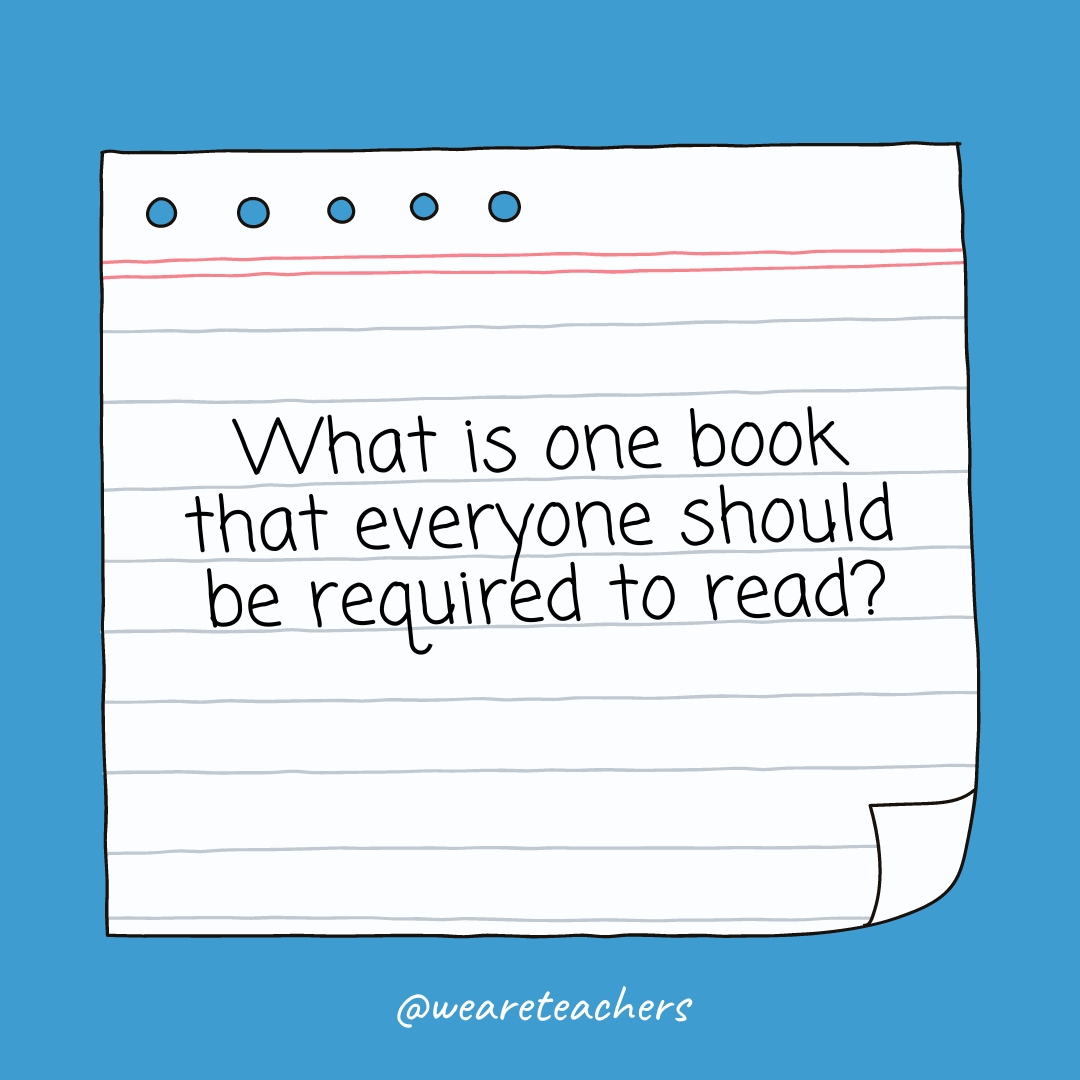
- Is democracy the best form of government?
- Is capitalism the best form of economy?
- Students should/should not be able to use their phones during the school day.
- Should schools have dress codes?
- If I could change one school rule, it would be …
- Is year-round school a good idea?
A research essay is a classic high school assignment. These papers require deep research into primary source documents, with lots of supporting facts and evidence that’s properly cited. Research essays can be in any of the styles shown above. Here are some possible topics, across a variety of subjects.
- Which country’s style of government is best for the people who live there?
- Choose a country and analyze its development from founding to present day.
- Describe the causes and effects of a specific war.
- Formulate an ideal economic plan for our country.
- What scientific discovery has had the biggest impact on life today?
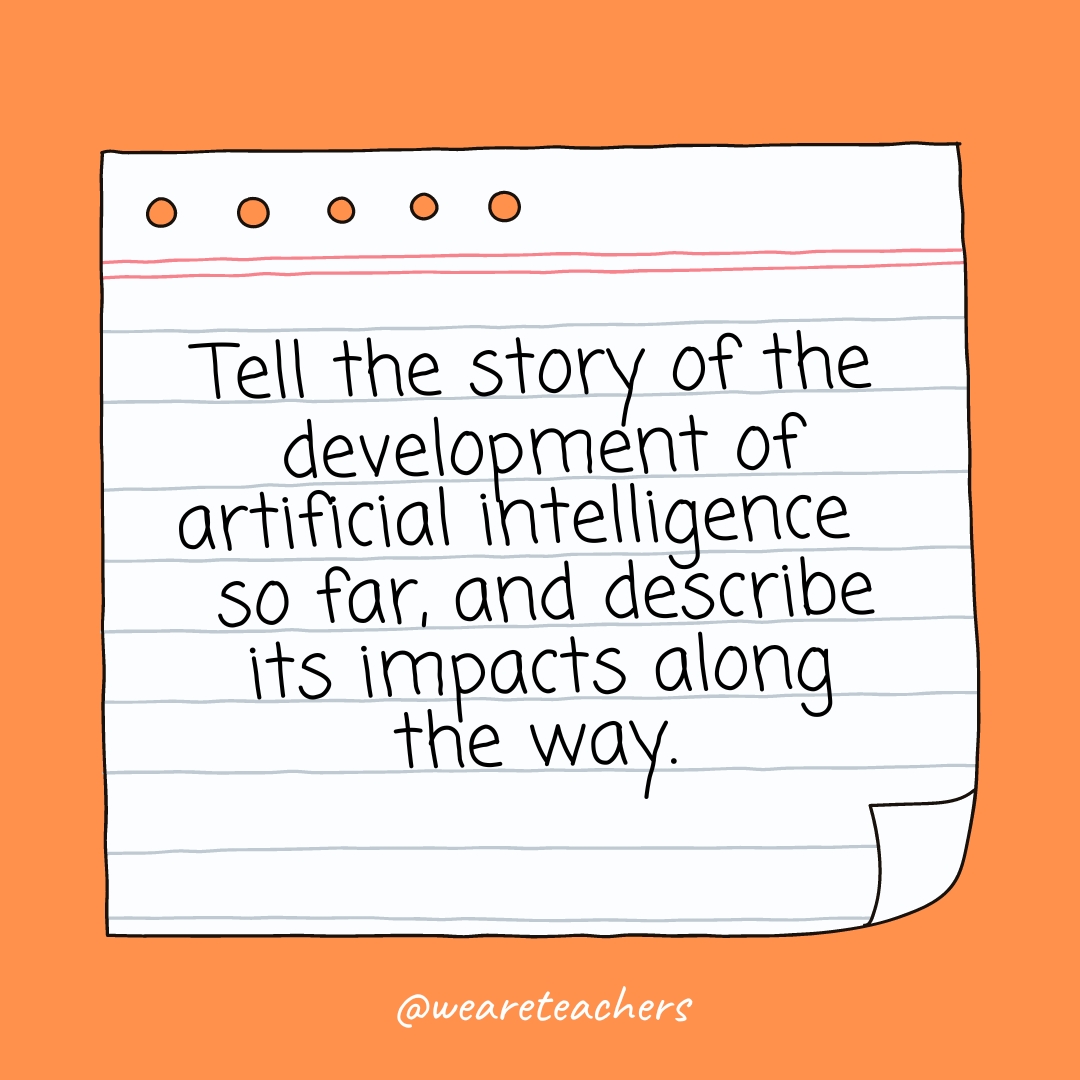
- Analyze the way mental health is viewed and treated in this country.
- Explore the ways systemic racism impacts people in all walks of life.
- Defend the importance of teaching music and the arts in public schools.
- Choose one animal from the endangered species list, and propose a realistic plan to protect it.
What are some of your favorite essay topics for high school? Come share your prompts on the WeAreTeachers HELPLINE group on Facebook .
Plus, check out the ultimate guide to student writing contests .
We Are Teachers
You Might Also Like
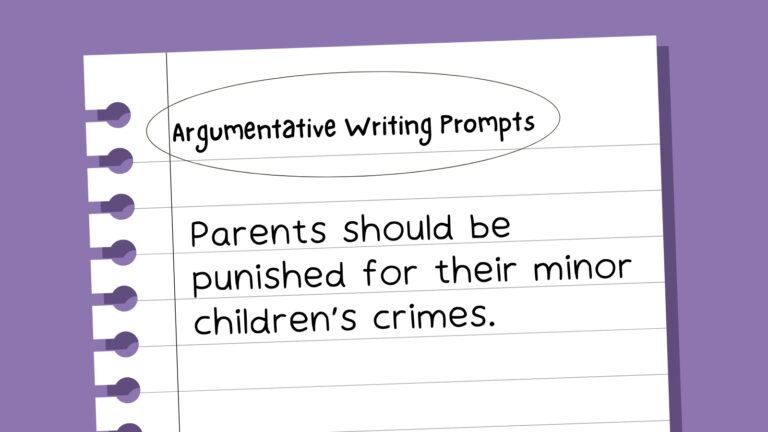
100 Thought-Provoking Argumentative Writing Prompts for Kids and Teens
Practice making well-reasoned arguments using research and facts. Continue Reading
Copyright © 2024. All rights reserved. 5335 Gate Parkway, Jacksonville, FL 32256
- Share full article
Advertisement
Supported by
Is Fluoridated Drinking Water Safe for Pregnant Women?
New research suggests a link between prenatal fluoride levels and behavioral issues in children. Experts are divided on the study’s significance.

By Alice Callahan and Christina Caron
A small study published Monday suggested that higher levels of fluoride consumed during the third trimester of pregnancy were associated with a greater risk of behavioral problems in the mothers’ children at 3 years old. The authors of the study, which was funded in part by the National Institutes of Health and the Environmental Protection Agency and published in the journal JAMA Network Open, believe it is the first to examine links between prenatal fluoride exposure and child development among families living in the United States, where fluoride is often added to community water supplies to prevent dental cavities.
The study’s authors and some outside researchers said that the findings should prompt policymakers to evaluate the safety of fluoride consumption during pregnancy.
“I think it’s a warning sign,” said Dr. Beate Ritz, an environmental epidemiologist at the U.C.L.A. Fielding School of Public Health.
But other experts cautioned that the study had several important limitations that made it difficult to assess the potential effects of fluoride consumption during pregnancy.
“There is nothing about this study that alarms me or would make me recommend that pregnant women stop drinking tap water,” said Dr. Patricia Braun, a professor of pediatrics at the University of Colorado School of Medicine and a spokesperson for the American Academy of Pediatrics.
The Background
Fluoride strengthens tooth enamel, and research suggests that drinking water with added fluoride can reduce cavities by up to 25 percent . Many communities in the United States have added fluoride to their water for this reason since the 1940s, a practice widely celebrated as a major public health achievement . In 2020, 63 percent of people in the United States lived in areas with at least 0.7 milligrams per liter of fluoride in the water — considered optimal for cavity prevention — though some areas have levels that are higher , in part because of naturally high fluoride in the groundwater.
In the last few years, several studies from Mexico and Canada have suggested that fluoride exposure during pregnancy is linked to slightly lower scores on intelligence tests and other measures of cognitive function in children.
But recent studies from Spain and Denmark have found no such link.
There is a “contentious debate” about water fluoridation, acknowledged Ashley Malin, an assistant professor of epidemiology in the College of Public Health and Health Professions at the University of Florida and the lead author of the new study. The issue is currently the subject of a lawsuit filed by the nonprofit Food and Water Watch and other groups against the Environmental Protection Agency. The nonprofit claims that water fluoridation poses a risk to children’s health.
The Research
The study looked at a group of 229 predominantly low-income Hispanic pregnant women in Los Angeles who were already being followed in other research. Most of the women lived in areas with fluoridated water. The researchers measured the fluoride levels in their urine in a single test during the third trimester. Then, when their children were 3 years old, the mothers filled out the Preschool Child Behavior Checklist , a measure used to detect emotional, behavioral and social problems.
Overall, 14 percent of the children had a total score in the “borderline clinical” or “clinical” range, meaning that a doctor may want to watch or evaluate them, or provide additional support, Dr. Malin said. And on average, higher fluoride levels in the mothers’ urine were correlated with a greater risk of behavioral problems in the children. The researchers found that women with urine fluoride levels at the 75th percentile were 83 percent more likely to have children with borderline or clinically significant behavioral problems than women with levels at the 25th percentile.
The main problems reported by the mothers were emotional reactivity, which is the tendency to overreact; somatic complaints, such as headaches and stomachaches; anxiety; and symptoms linked to autism (though those symptoms alone would not be enough for an autism diagnosis).
The researchers did not find an association with other behavioral symptoms like aggression or issues with concentration.
The findings are important and add to evidence suggesting prenatal fluoride consumption may affect the developing brain, said Joseph Braun, a professor of epidemiology and the director of the Center for Children’s Environmental Health at Brown University, who was not involved in the research. That said, the increases in behavioral scores were relatively small — about two points on a scale from 28 to 100 for overall behavioral problems. It’s hard to say whether such a difference might be noticeable in an individual child, he said.
But given how widespread water fluoridation is, he added, even minor behavioral changes in individual children could have a meaningful impact on the overall population.
The Limitations
The study was relatively small and didn’t include a diverse group of women. It didn’t account for many factors that can affect child development, including genetics , maternal nutrition, home environment and community support, several experts not involved in the study said.
The data would also have been stronger if the researchers had measured fluoride in urine samples from several points of time during pregnancy and collected information on tap water, bottled water and tea consumption to better understand how each contributed to the women’s fluoride levels, experts said. Black and green teas can contain high levels of fluoride.
The Preschool Child Behavior Checklist that was used to evaluate the 3-year-olds is considered a reliable measure of child behavior. But it did not take into account the fact that symptoms can change in frequency and intensity during early childhood, said Catherine Lord, an expert on autism and related disorders at the University of California, Los Angeles medical school.
Dr. Lord, who was not involved in the fluoride research, added that the checklist is not considered a reliable way to diagnose autism.
It would also be helpful to follow the children to see if the problematic behaviors persisted beyond age 3, said Melissa Melough, an assistant professor of nutrition sciences at the University of Delaware, who was not involved in the research.
What’s Next
While the experts agreed that more robust research was needed to untangle the potential effects of prenatal fluoride exposure, they had differing opinions about the study’s bottom line.
Dr. Malin said that, based on her findings and the evidence from previous studies, it might be a good idea for women to limit fluoride intake during pregnancy, a view that was echoed by Dr. Ritz and others.
“For me, the takeaway is: Protect pregnancy,” said Marcela Tamayo-Ortiz, an environmental epidemiologist at the Columbia University Mailman School of Public Health who has studied prenatal exposures for more than two decades.
But the American Dental Association said in a statement that the organization stands by its recommendation to “brush twice a day with fluoride toothpaste and drink optimally fluoridated water.”
And Dr. Nathaniel DeNicola, an OB-GYN and environmental health expert in Orange County, Calif., said he wouldn’t advise his pregnant patients to avoid fluoridated water based on the study, because “it’s not conclusive.”
Dr. Melough said she didn’t think women should be alarmed by the findings. But, she added, while it’s clear that fluoride helps to reduce cavities, it’s possible that adding it to the water “could have some unintended consequences,” and policymakers should continually evaluate the practice as new science emerges.
You can find out what the fluoride levels are in your local water by contacting your water utility or checking the C.D.C.’s My Water’s Fluoride website . If you want to reduce your fluoride consumption, experts said, limit how much black or green tea you drink. You can also purchase certain water filters that remove some fluoride. There’s no reason to stop brushing your teeth with fluoride toothpaste — just don’t swallow it.
Alice Callahan is a Times reporter covering nutrition and health. She has a Ph.D. in nutrition from the University of California, Davis. More about Alice Callahan
Christina Caron is a Times reporter covering mental health. More about Christina Caron

IMAGES
VIDEO
COMMENTS
Essay Writing: Writer's Checklist Introduction: Is the main idea (i.e., the writer's opinion of the story title) stated clearly? Is the introductory paragraph interesting? Does it make the reader want to keep on reading? Body Paragraphs: Does each body paragraph have a clear topic sentence that is related to the main idea of the essay?
Microsoft Word - K12ELA6-5.3.3.1-Amy Kasten's-Argumentative-Essay-Revision-Checklist.docx. Argumentative Essay: Revision Checklist. REVISION CHECKLIST: Directions: Find, highlight, and revise these elements in your informational article. **If you don't have one of these things, ADD it!**. _____ The essay includes an attention-grabbing hook ...
By completing a peer review you will be able to create a better thesis statement and supporting arguments. Using a checklist to complete your review will allow you to rate each of the parts in the paper according to their strength. There are many different peer review checklists, but the one below should be helpful for your assignment.
For a high school essay, this could be just three paragraphs, but for a graduate school essay of 6,000 words, the body could take up 8-10 pages. Paragraph structure. To give your essay a clear structure, it is important to organize it into paragraphs. Each paragraph should be centered around one main point or idea. ... Checklist: Essay 0 / 14.
Create an outline. Make a rough outline of the sections and points of your essay. Writing your ideas down will help you organize your thoughts and see what you need to add, change, or rearrange. Provide evidence. Use evidence from your research to support your ideas.
When you write an essay for a course you are taking, you are being asked not only to create a product (the essay) but, more importantly, to go through a process of thinking more deeply about a question or problem related to the course. By writing about a source or collection of sources, you will have the chance to wrestle with some of the
270 pages of the most effective teaching strategies; 50+ digital tools ready right out of the box 75 editable resources for student differentiation ; Loads of tricks and tips to add to your teaching tool bag; All explanations are reinforced with concrete examples.; Links to high-quality video tutorials; Clear objectives easy to match to the demands of your curriculum
High School Version Use the checklist below to help you revise your rough draft before you copy it into your writing folder. IDEAS AND CONTENT My paper has a clear purpose or makes a point. I choose clear details and examples to help the reader understand my message. I stick to the main idea. I leave out details that do not matter.
Checklist: Essay 0 / 14. My essay follows the requirements of the assignment (topic and length). My introduction sparks the reader's interest and provides any necessary background information on the topic. My introduction contains a thesis statement that states the focus and position of the essay. I use paragraphs to structure the essay.
Once you have found (and read) your sources, take note of pieces of information you think could back up your thesis. 4. Create An Outline. Creating an outline of your essay will help make the writing process much easier. It is a way to organize your thoughts and structure them in a way that makes sense.
Janelle Schwartz, English 201. This is to give you an idea of the type of things you should be looking for and accomplishing in both your own paper and that of your peer (s). Use what follows as a kind of checklist for determining what is working effectively in a paper and what is not. Introduction. Has the writer (either yourself or your ...
Richard Nordquist. Updated on October 14, 2019. After you have completed one or more drafts of your narrative essay, use the following checklist as a revision and editing guide to prepare the final version of your composition. In your introduction, have you clearly identified the experience you are about to relate?
Sample College Essay 2 with Feedback. This content is licensed by Khan Academy and is available for free at www.khanacademy.org. College essays are an important part of your college application and give you the chance to show colleges and universities your personality. This guide will give you tips on how to write an effective college essay.
Structure Checklist: Three Major Elements. Within essay writing checklist, structure of essays plays a relevant role. There should be introduction, body, and conclusion, each of them having a specific size and vital components. This is what students should remember: intro and conclusion should take between 7-10% of the overall word count.
List any emotionally charged words that the writer might want to change. List two facts that are particularly relevant and credible for making the reader want to consider the writer's viewpoint. List one idea that might need some work to accomplish the goal of making the reader consider the writer's viewpoint. Do ideas seem connected?
Most main college essays (like the Common App essays) have a word limit of anywhere from 250-650 words. Supplemental essay prompts generally have word limit of 100-400 words. Either way, you need to make sure that you stay very close to the upper word limit in your response. As a general rule, you should try to stay within 10% of the upper word ...
Plus, The Big List of Essay Topics for High School (120+ Ideas!). Share this article. Yes, I want teaching tips & resources! Subscribe. Choose your grade level: Elementary Secondary Recommended. 15 Inspiring Personal Narrative Examples for Writers. Reveal a part of yourself in your essay.
IEW® in High School. The high school years can be daunting, but writing does not have to be. IEW teaches students how to navigate the essays, research papers, and literary analysis that they will need to succeed in high school and beyond. IEW's pathway for high school is designed to help beginning students gain confidence while continuing to ...
After the self-edit is complete, discuss the process with the students. Next, choose another student to serve as the peer editor for the piece that was just self-edited. Have the two students sit in the middle of the class so that all students can see and hear them as they work through the peer-editing phase. Afterward, include the entire class ...
The following ideas work well for compare-contrast essays. ( Find 80+ compare-contrast essay topics for all ages here.) Public and private schools. Capitalism vs. communism. Monarchy or democracy. Dogs vs. cats as pets. WeAreTeachers. Paper books or e-books. Two political candidates in a current race.
A persuasive essay will require a checklist with evidence of opinions and data to back up claims, whereas a narrative essay may need criteria for evaluating figurative language usage. But don't be ...
Essay Writing Checklist - High School and Middle School. by . A Teacher's Teacher. 4.8 (6) $1.50. PDF. This essay writing checklist is a wonderful tool that can be provided for students to help guide the essay writing process. With point-by-point requirements for all parts of an essay (introduction, body paragraphs, and conclusion), students ...
Directions: Each member of the group will proofread your paper. Each peer must write his/her name on the lines above. The first peer reads first answering ONLYthe content questions, and the second peer reads second answers ONLY the grammar questions. Then reverse it. This way each of you will submit one COMPLETED Peer editing sheet. Content ...
Black and green teas can contain high levels of fluoride. The Preschool Child Behavior Checklist that was used to evaluate the 3-year-olds is considered a reliable measure of child behavior.